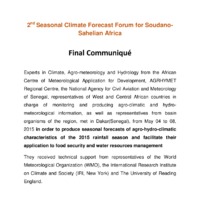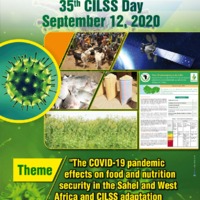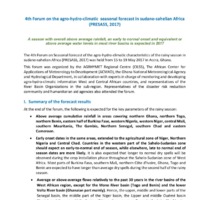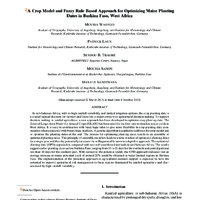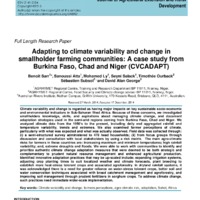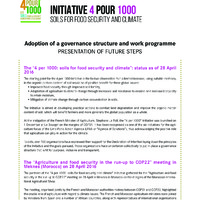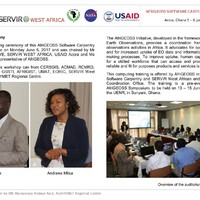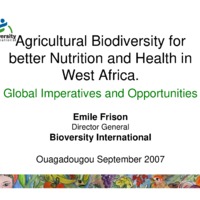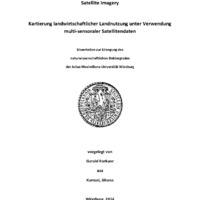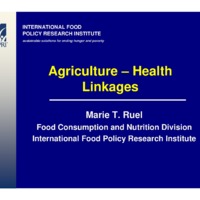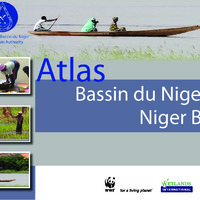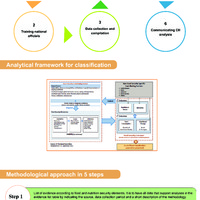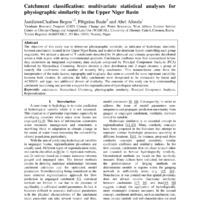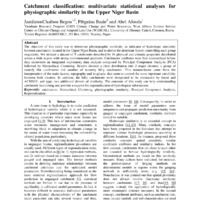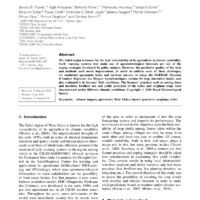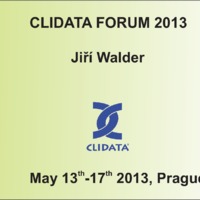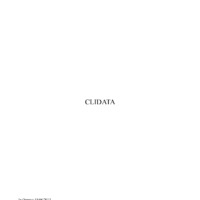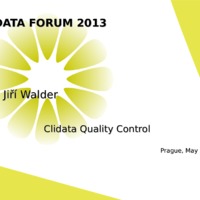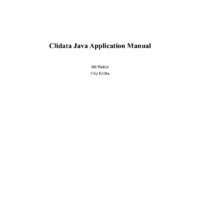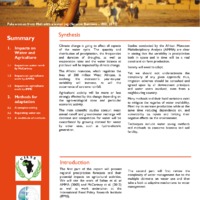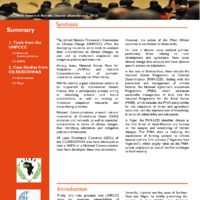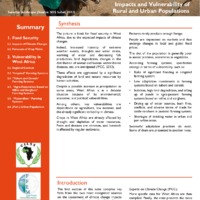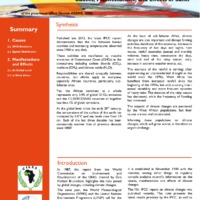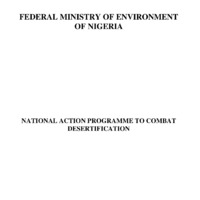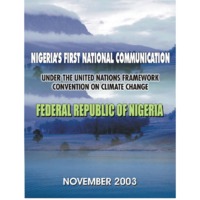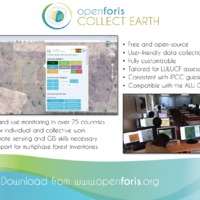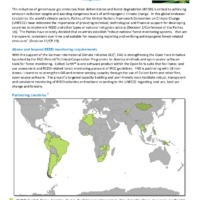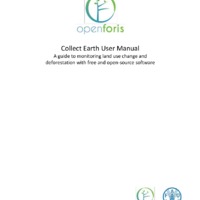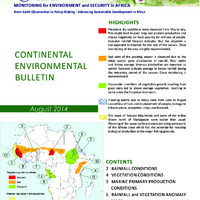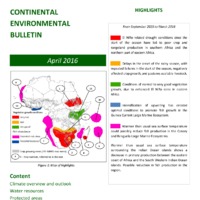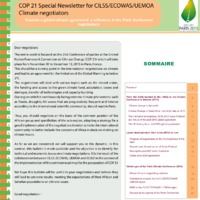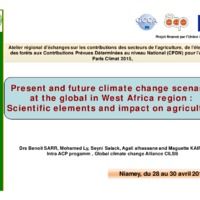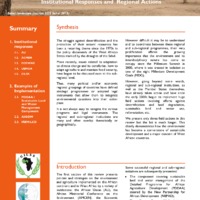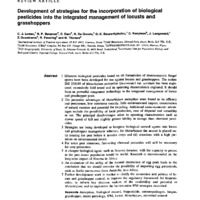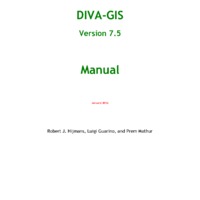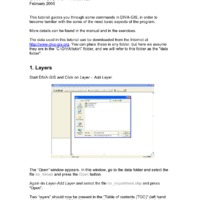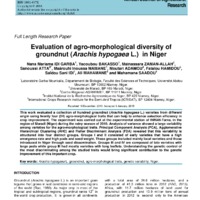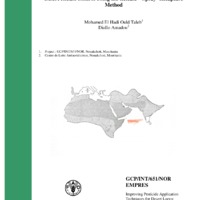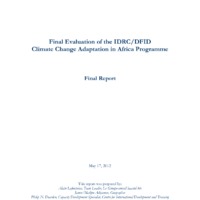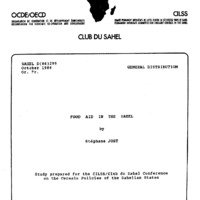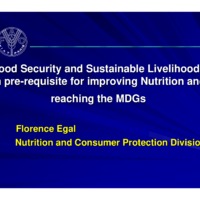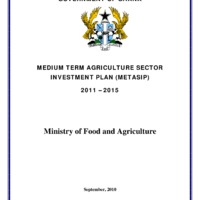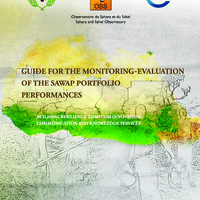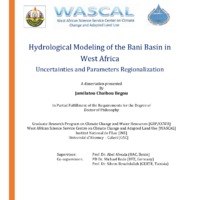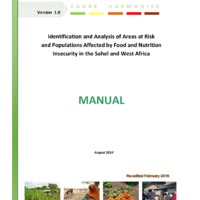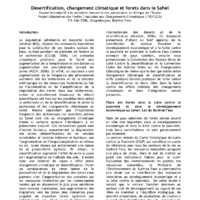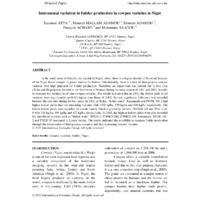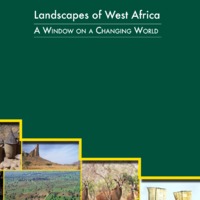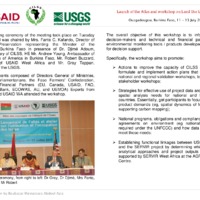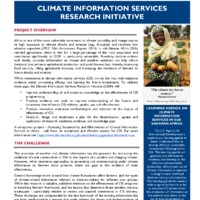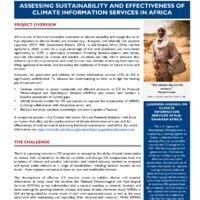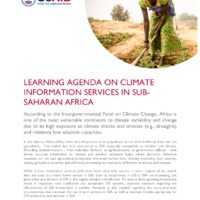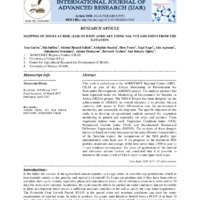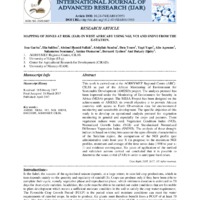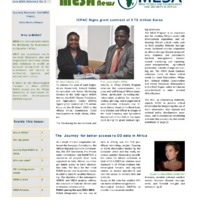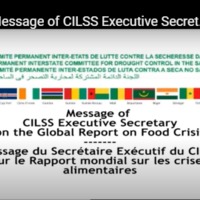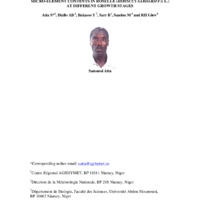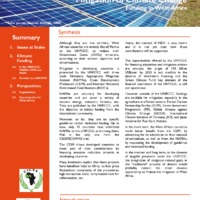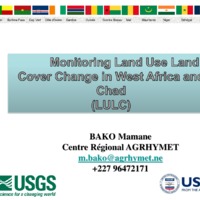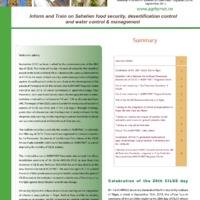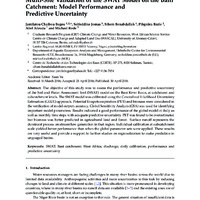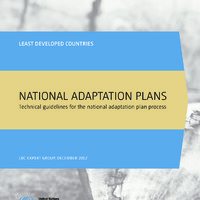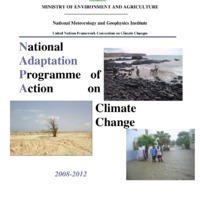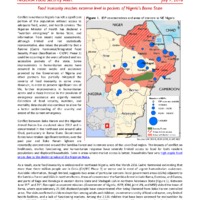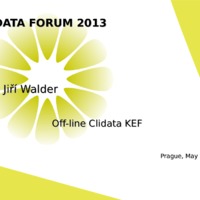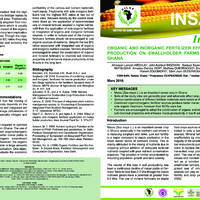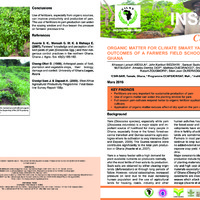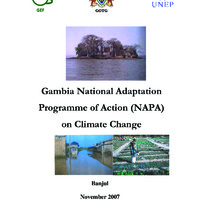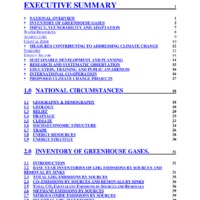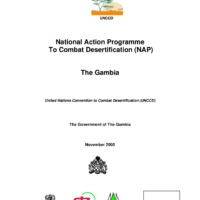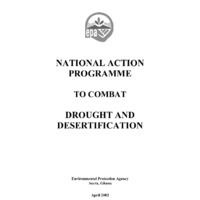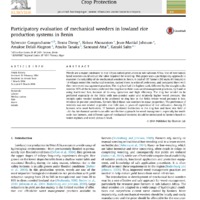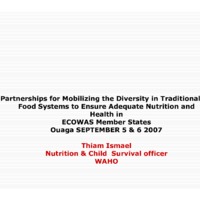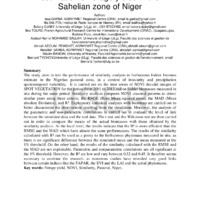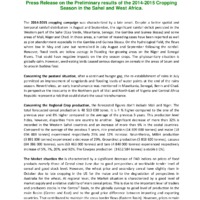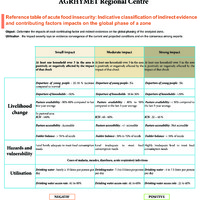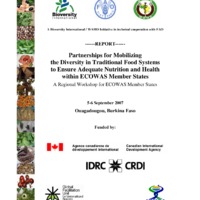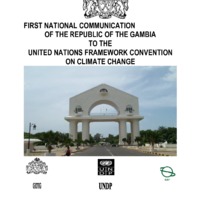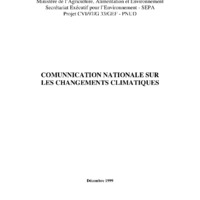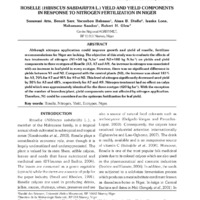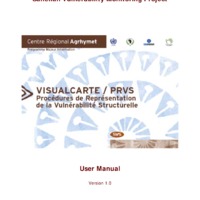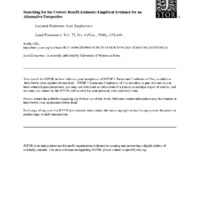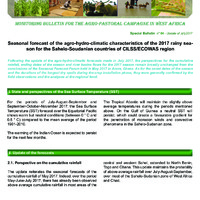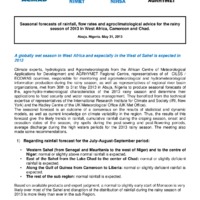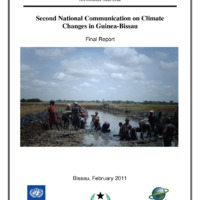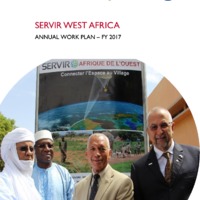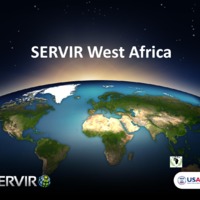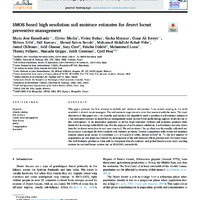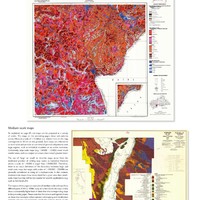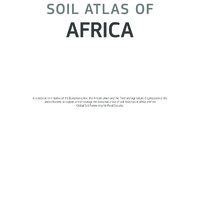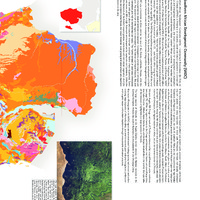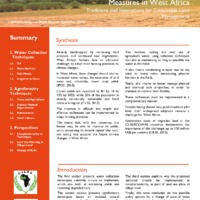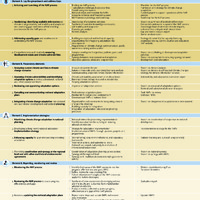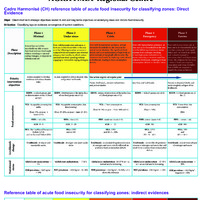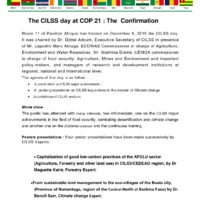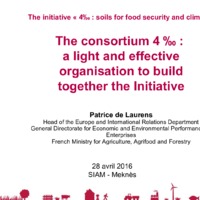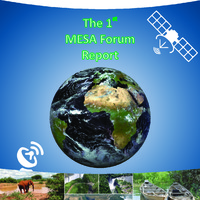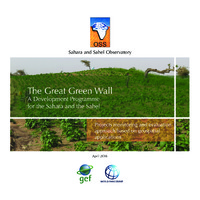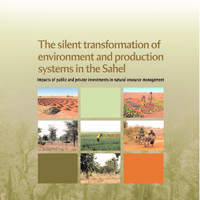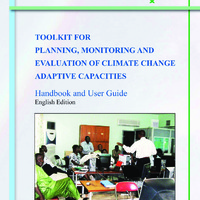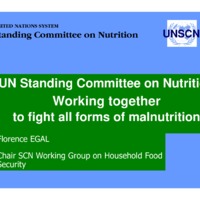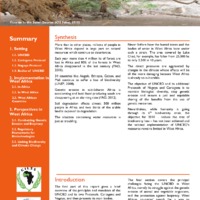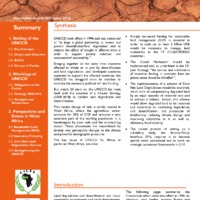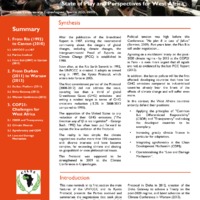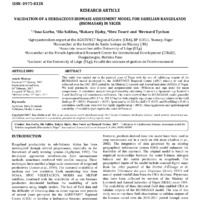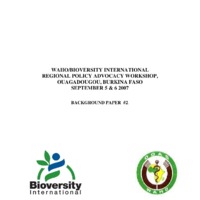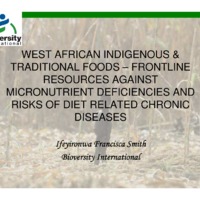Recherche
149 items
Operational guide on AGRHYMET RCC-WAS services
This operational guide is dedicated to public, academic and private institutions working in the fields of climate, water, environment, agriculture, livestock, plant protection, food and nutrition security, climate disaster risk reduction, and any other related sectors using (or wishing to use) the products and services of AGRHYMET Regional Climate Centre for West Africa and the Sahel (AGRHYMET RCC-WAS), which is a specialized
agency of the Permanent Inter-State Committee for Drought Control in the Sahel (CILSS). Its main objective is to enhance the value of AGRHYMET RCC-WAS's various products and services, by making them more visible and attractive to development stakeholders (public, academic and private), decision-makers and partners
(technical and financial), through their performance, relevance, and effectiveness in meeting the specific and collective needs of different users in the countries of West Africa, the Sahel, and other zones. The guide maps out the various services provided by AGRHYMET RCC-WAS, which is a benchmark institution in the sub-region for diploma and continuing training in the various fields listed above, and for building the operational capacities of state, university and private technical institutions involved in reducing hydro-climatic and phytosanitary risks and improving the productivity of agro-sylvo-pastoral and environmental systems in West Africa and the Sahel. It explains the different types of services that AGRHYMET RCC-WAS provides or can provide, as well as the modalities and procedures that state technical institutions and other applicants must adopt to gain access to them, in accordance with their specific or collective, immediate, or future needs, and in compliance with environmental and social safeguard standards.
2nd Seasonal Climate Forecast Forum for Soudano- Sahelian Africa: Final Communiqué
Experts in Climate, Agro-meteorology and Hydrology from the African Centre of Meteorological Application for Development, AGRHYMET Regional Centre, the National Agency for Civil Aviation and Meteorology of Senegal, representatives of West and Central African countries in charge of monitoring and producing agro-climatic and hydrometeorological information, as well as representatives from basin organisms of the region, met in Dakar(Senegal), from May 04 to 08,
2015 in order to produce seasonal forecasts of agro-hydro-climatic characteristics of the 2015 rainfall season and facilitate their application to food security and water resources management
35th CILSS Day September 12, 2020
"The COVID-19 pandemic effects on food and nutrition security in the sahel and west Africa and CILSS adaptation efforts for information production"
4th Forum on the agro-hydro-climatic seasonal forecast in sudano-sahelian Africa (PRESASS, 2017)
A season with overall above average rainfall, an early to normal onset and equivalent or above average water levels in most river basins is expected in 2017.
A Crop Model and Fuzzy Rule Based Approach for Optimizing Maize Planting Dates in Burkina Faso, West Africa
In sub-Saharan Africa, with its high rainfall variability and limited irrigation options, the crop planting date is a crucial tactical decision for farmers and therefore a major concern in agricultural decision making.
A successful experimentto promote peaceful livestockmobility as a cornerstone of production and marketing systems in West Africa
The N’Djamena symposium in the Republic of Chad (May 2013) and the Nouakchott
declaration in the Islamic Republic of Mauritania (October 2013) have given renewed
interest to the livestock sector in view of its significant contribution to people’s incomes
and food security. The PREDIP (Projet régional de dialogue et d’investissement pour
le pastoralisme et la transhumance transfrontalière au Sahel et dans les pays côtiers
de l’Afrique de l’Ouest - Regional Dialogue and Investment Project on Pastoralism and
Transhumance in the Sahel and Coastal West Africa (PREDIP), along with several other
regional initiatives (PRAPS, PEPISAO, etc.) was then implemented to promote and
enhance mobile livestock farming. Implemented between 2018 and 2024, PREDIP covered eight (08) countries, including five (05) coastal countries (Benin, Côte d’Ivoire, Ghana, Nigeria, and Togo) and three (03) Sahelian countries (Burkina Faso, Mali and Niger), with the main approach being to target cross-border areas between the south of Sahelian countries and the north of coastal countries. These areas, which are known to have a high concentration of animals, are also known to be conflict-ridden due to the exploitation of pastoral resources shared between users. Over the five (05) years of its implementation, PREDIP has provided innovative solutions to the unique challenges of managing pastoral resources, transhumance and interactions between pastoralists and farmers in Sahelian and coastal areas. Whether in terms of improving information systems, sector governance, setting up agro-pastoral infrastructure and facilities or promoting animal health, PREDIP has made significant gains and learnt from its practices. This summary note presents the Project’s main milestones, its achievements, its positive impact, as well as the innovations and best practices that have emerged from its implementation. In view of the challenges that have been met and the results that have been achieved, this brochure also bears witness to the unwavering commitment of all those involved in the successes achieved by PREDIP.
Adapting « alternate wetting and drying irrigation » technique in the dry prone area for strengthen climate resilience in Burkina Faso, West Africa
In this study, a field experiment based on alternate wetting and drying irrigation «AWDI» technique was implemented to identify optimal water depth that could be used to better mitigate the impact of water scarcity in dry prone area such as Burkina Faso. That should empower farmers resilience to climate change by improving water productivity in order to sustain rice production in Burkina Faso
Adapting to climate variability and change in smallholder farming communities: a case study from Burkina faso, Chad and Niger
Climate variability and change is regarded as having major impacts on key sustainable socio-economic and environmental indicators in Sub-Saharan West Africa. Because of these concerns, we investigated smallholders knowledge, skills, and aspirations about managing climate change, and document adaptation strategies used in the semi-arid regions coming from Burkina Faso, Chad and Niger. We analyzed climate data from the 1950’s to the present, including daily and aggregated rainfall and temperature variability, trends and extremes.
Adoption of a governance structure and work programme presentation of future steps
Adoption of a governance structure and work programme PRESENTATION OF FUTURE STEPS
AGRHYMET Regional Centre
This evaluation was conducted by Ulrich Diasso (PhD) for the United Nations Development Programme (UNDP) and the AGRHYMET Regional Centre under the Swedish-supported Sahel Resilience Project. We are grateful to our national and international partners for their availability and support to online and on-site interviews with relevant experts and site visits: national meteorological and hydrological institutions, disaster risk management and early warning services in the seven partner countries to the Sahel Resilience Project, as well as officials from regional bodies, namely the Economic Community of West African States (ECOWAS), the African Centre of Meteorological Applications for Development (ACMAD), the Niger Basin Authority (NBA), the Volta Basin Authority (VBA) and the Lake Chad Basin Commission (LCBC).
We would like to express our deep gratitude to international partners and UN agencies: the Food and Agriculture Organization of the United Nations (FAO) Regional Office for West Africa and its office in Senegal, the United Nations Office for Disaster Risk Reduction (UNDRR), the Institute for Security Studies for Africa (ISS) and the CIMA Foundation (International Centre for Environmental Monitoring) of the Italian National Centre of Civil Protection.
Agricultural land use mapping in west africa using multi-sensor satellite imagery
Rapid population growth in West Africa has led to expansion in croplands due to the need to grow more food to meet the rising food demand of the burgeoning population. These expansions negatively impact the sub-region's ecosystem, with implications for water and soil quality, biodiversity and climate. In order to appropriately monitor the changes in croplands and assess its impact on the ecosystem and other environmental processes, accurate and up-to-date information on agricultural land use is required. But agricultural land use mapping (i.e. mapping the spatial distribution of crops and croplands) in West Africa has been challenging due to the unavailability of adequate satellite images (as a result of excessive cloud cover), small agricultural fields and a heterogeneous landscape. This study, therefore, investigated the possibilities of improving agricultural land use mapping by utilizing optical satellite images with higher spatial and temporal resolution as well as images from Synthetic Aperture Radar (SAR) systems which are nearindependent of weather conditions. The study was conducted at both watershed and regional scales.
Atlas du bassin du niger
Cet ouvrage est consacré au Niger, le fleuve des fleuves. Ce cours d’eau traverse quatre pays mais son bassin draine neuf (9) Etats d’Afrique de l’Ouest représentant un kaléidoscope de cultures et de paysages. Son nom original, «egerou n-igereou», signifie «fleuve des fleuves». Il lui a été donné par les Touaregs, qui voulurent ainsi souligner le caractère exceptionnel qu’avait pour eux ce cours d’eau. Le fleuve Niger est le 4ème bassin hydrographique d’Afrique avec ses 4.200 km de long et dont le bassin couvre environ 2,1 millions de km2 de superficie totale pour 1,5 millions de km2 de bassin actif. La gestion intégrée de ce potentiel hydrique et de ses écosystèmes associés est un enjeu majeur pour les Etats membres de l’Autorité du Bassin du Niger (ABN) et ses partenaires comme l’attestent les différentes thématiques abordées dans cet ouvrage. Nous sommes aujourd’hui tous conscients des priorités de développement du bassin et j’en suis convaincu que cet ouvrage contribuera à faire mieux connaître le bassin du Niger dans toute sa diversité aux plans tant national qu’international, et servira d’inspiration pour atteindre les objectifs de la Vision partagée. Enfin, cette publication est le témoignage d’une collaboration fructueuse entre l’ABN et deux ONG Internationales partenaires, le Fonds Mondial pour la Nature (WWF) à travers son Programme Eaux douces pour l’Afrique de l’Ouest et Wetlands International.
BRICKS supports SAWAP by providing operational services to country projects to help identify regional and global innovations, promote them through better communication, and put that knowledge into use.
These agencies and their partners will provide on-demand technical assistance, advisory services, and a regional platform for cross-fertilization of what works, where, and under what enabling conditions.
Catchment classification: multivariate statistical analyses for physiographic similarity in the upper niger basin
The objective of this study was to determine physiographic similarity, as indicator of hydrologic similarity between catchments located in the Upper Niger Basin, and to derive the dominant factors controlling each group singularity. We utilized a dataset of 9 catchments described by 16 physical and climatic properties distributed across a wide region with strong environmental gradients. Catchments attributes were first standardized before they underwent an integrated exploratory data analysis composed by Principal Component Analysis (PCA) followed by Hierarchical Clustering. Results showed a clear distribution into 2 major clusters: a group of easterly flat catchments and another of westerly hilly catchments. This nomenclature came from the interpretation of the main factors, topography and longitude, that seem to control the most important variability between both clusters. In addition, the hilly catchments were designated to be dominated by forest and ACRISOL soil type, two additional drivers of similarity. The outcome of this study can help understanding catchment functioning and provide a support for regionalization of hydrological information.
Catchments classification: multivariate statistical analysis for physiographic similarity in the niger basin
The Bani basin was classified into 4 clusters of similar catchments (Figures 2-4), The topographic variables (Elev, ElevMin, ElevMax, Slo1), precipitation and the geographical position of the sub-catchment (Lat) were demonstrated to be the most important causes of similarity between catchments belonging to Cluster 2 and Cluster 4 (Table 2), This study permitted to propose the two nomenclature: Group of northerly flat and semi-arid catchments, and group of southerly hilly and humid catchments.
Characterizing and modeling the diversity of cropping situations under climatic constraints in west africa
The Sahel region is known for the high vulnerability of its agriculture to climate variability. Early warning systems that make use of agrometerological forecasts are one of the coping strategies developed by policy makers. However, the predictive quality of the tools and methods used needs improvement. In order to address some of these challenges, we conducted agronomic trials and on-farm surveys to adapt the SARRAH (Syst`eme d’Analyse R´egionale des Risques Agroclimatiques, version H) crop simulation model, and also evaluated it in farmers’ field conditions. The farmers’ practices such as sowing dates and densities, fertilizer use and yields potentials of the millet and sorghum crops were characterized under different climatic conditions.
Climate change impacts on water and agriculture in west africa
Climate change is going to affect all aspects of the water cycle. The quantity and distribution of precipitation, the frequencies and duration of droughts, as well as evaporation rates and the water balance at plot level will be impacted by climate change. The African monsoon, which regulates the lives of 300 million West Africans, is evolving: the monsoon’s year-to-year variability will increase, as will the occurrence of extreme rainfall. Agricultural activity will be more or less strongly affected by this change depending on the agro-ecological zone and particular economic activity. The main scientific studies concur: mean annual runoff and groundwater recharge will decrease and competition for water will be exacerbated by growing demand for water by other uses, such as hydro-electric generation. Studies conducted by the African Monsoon Multidisciplinary Analysis (AMMA) are clear in stating that the variability in precipitation both in space and in time will be a real constraint on farm production. Society will need to adapt. Yet we should not underestimate the complexity of any given approach; thus, irrigation schemes should be consulted and agreed upon by all downstream principals and water users involved, even from a neighbouring country. Many methods and their local variations exist to mitigate the vagaries of water availability. Most try to increase production while at the same time reducing dependence on, and vulnerability to, inputs and limiting their negative effects on the environment. Techniques include water saving methods and methods to conserve biomass and soil fertility.
Climate change responses from west african states
The United Nations Framework Convention on Climate Change (UNFCCC) offers the developing countries some tools to evaluate their vulnerabilities to climate changes, to plan and to implement adaptation and mitigation policies and measures. Among them, National Action Plans for Adaptation (NAPAs) and National Communications are of particular importance, especially for West Africa. NAPAs identify urgent adaptation actions to be supported by international climate finance, after a participatory process aiming at identifying present and future vulnerabilities, as well as existing or innovative adaptation measures, and hierarchizing priorities. National Communications present national inventories of Greenhouse Gases (GHG) emissions and removals, as well as countries’ vulnerabilities in terms of climate changes, thus identifying adaptation and mitigation policies and measures. All Least Developed Countries (LDCs) of the CILSS/ECOWAS area have developed at least a NAPA or a National Communication; most have developed these two documents. However, the action of the West African countries is not limited to these tools. For over a decade, many national policies, particularly those relating to rural development and agriculture, have taken climate change into account and have planned specific actions on adaptation. In the case of Burkina-Faso, these include the National Action Programme to Combat Desertification (PAN-LCD), dealing with the prevention and management of climate hazards, the National Agriculture Investment Programme (PNIA) which addresses sustainable management of land, and the National Programme for the Rural Sector (PNSR), which includes the PNIA and provides for the adaptation of forest and agricultural resources, and the improvement of knowledge in terms of vulnerability and adaptation. In Niger, the PAN-LCD identifies climate as the first driver of desertification and focuses on the analysis and monitoring of climate changes. The PNIA aims at reducing the dependence of farming systems to climate hazards and the 3-N initiative ("Nigeriens feed Nigeriens"), which largely relies on the PNIA, quotes adaptation as one of the five challenges to food security.
Climate changes and food security impacts and vulnerability of rural and urban populations
The picture is bleak for food security in West Africa, due to the expected impacts of climate changes. Indeed, increased intensity of extreme weather events, droughts and water stress, warming of water and decreasing fish production, land degradation, changes in the distribution of animal and human vector-borne diseases, etc. are anticipated (IPCC, 2013). These effects are aggravated by a significant degradation of land and natural resources by human activities. Despite a possible increase in precipitation in some areas, West Africa is in a delicate situation because of its environmental, economic, and political vulnerabilities. Among others, key vulnerabilities are dependence on agriculture, low incomes, and the already significant variability in climate. Crops in West Africa are already affected by drought and depletion of water resources. Pests and diseases are common, and livestock is affected by regular outbreaks. Pastures rarely produce enough forage. People are dependent on markets and thus undergo changes in local and global food prices. The diet of the population is generally poor in animal proteins, sometimes in vegetables. According farming systems, specificities emerge in terms of vulnerability, such as: • Risks of significant flooding in irrigated farming system; • Low adaptation investments in farming systems based on tubers and cereals; • Isolation, high land degradation, and silting up of ponds in agro-pastoral farming systems based on millet and sorghum; • Drying up of water sources, bush fires, conflicts, and adverse terms of trade for cattle ranchers in pastoral farming system; • Shortages of drinking water in urban and peri-urban areas. Successful adaptation practices do exist. Some of them are presented in another note
Climate changes causes, manifestations, and effects in sahel
Published late 2013, the latest IPCC report demonstrates that the link between human activities and increasing temperatures observed since 1950 is very likely. These activities are manifested by massive emissions of Greenhouse Gases (GHGs) in the atmosphere, including carbon dioxide (CO2), methane (CH4), and nitrous oxide (N2O). Responsibilities are shared unequally between countries, but effects apply to everyone, especially African countries, particularly subSaharan ones. Yet, the African continent as a whole represents only 3.4& of global GHGs emissions and the CILSS/ECOWAS countries all together less than 1& of global emissions. At the global level, since the early 20th century, the temperature of the surface of the earth has increased by 0.8°C and sea levels rose from 19 cm. Each of the last three decades has been successively warmer than all previous decades since 1850! At the level of sub-Saharan Africa, climate changes are also important and disrupt farming activities, backbone of the economy: increase in the frequency of hot days and nights, heat waves, rainfall anomalies (annual and monthly volumes, heavy rains, consecutive dry days, start and end of the rainy season, etc.), increase in extreme weather events, etc. The example of the rainfall is striking: after experiencing an unprecedented drought in the world since the 1970s, West Africa has benefited from increased rainfall since the beginning of the 1990s, but with a strong interannual variability and more frequent episodes of heavy rains. The duration of the rainy season has decreased, while the frequency of flooding has increased. The impacts of climate changes are perceived by the West African populations, but their causes are not well understood. Informing these populations on climate changes, which will grow worse, is therefore an urgent challenge.
CNUCC NAPCD nigeria
The severity of desertification in the drylands of the world prompted the United Nations Organization to adopt a Convention to Combat Desertification (CCD), in 1994 for which National Action Programme (NAP) which Nigeria ratified in 1997. As a principal tool for the implementation of the Convention, parties are expected to prepare and implement NAP. Nigeria is a large country with a substantial part of its area extending into the Sudano-sahelian belt, which, together with the neigbouring northern Guinea savanna, constitutes the drylands of the country. With an estimated population of 113 million, human pressure on the land particularly in the marginal areas has continued to take its toll on the environment, resulting in desertification. Desertification is made very severe in the drylands of the country by increasing human attempts to exploit the resources of the ecological zone in the face of persistent drought. Before now, Nigeria has been tackling the problem of desertification the best way it could, but with little success. It is now obvious that the menace should be addressed in a holistic manner in order to ensure that the drylands of the country continue to support human and natural resources. This National Action Programme (NAP) spells out critical activities to be taken in a holistic manner to tackle the menace of desertification of the country. To facilitate a clear understanding of the NAP, an outline of the country’s environment is given, followed by a description of the extent and severity of desertification in the area. Also highlighted are the earlier efforts made to combat the menace, and the lesson learnt from such efforts. The NAP itself presents, guiding principles, issues, strategies and priority projects.
CNUCC Nigeria's initial national communication
Nigeria with a total area of 923,800 sq km occupies about 14& of land area in West Africa. The country lies between 4oN and 14oN, and between 3oE and 15oE. It is bordered respectively in the north, east, and west by Niger, the Cameroon, and Benin Republic, while the Gulf of Guinea, an arm of the Atlantic Ocean, forms the southern border. Most of Nigeria is covered with Pre- Cambrian rocks, but there are also metamorphic and sedimentary rocks of Eocene times as well as volcanic rocks. In general, three types of geologic structures exist in Nigeria, namely, areas of uplift, basins of sedimentation, and isolated volcanic areas. The areas of uplift are made up of the oldest rocks in Nigeria - the basement complex rocks.The basins of sedimentation are the down-warped areas, which were drowned by the sea at different times and in which sediments eroded from the areas of uplift were laid down.
Conflict sensitivity and prevention (CSP)
Checklist for the implementation of livestock sector activities or infrastructure projects in sub-Saharan pastoral areas The Conflict Sensitivity and Prevention (CSP) Checklist was developed as part of the "Pastoralism and Stability in the Sahel and Horn of Africa" programme (PASSHA, 2016-2017, World Bank). The PASSHA programme was
designed to support CILSS (the Permanent Inter-State Committee for Drought Control in the Sahel) and IGAD (the Inter-Governmental Authority on Development). It aims to integrate the Conflict Sensitivity and Prevention approach into the interventions of both institutions and strengthen their capacity in this area. Its content has been improved in the framework of the implementation of the Integrated and Secure Pastoralism in West Africa Project (PEPISAO 2018-2022). The checklist is a field tool associated with the Practical Guide to Conflict Sensitivity and Prevention in Livestock Sector Development Projects in Sub-Saharan Africa. It has been tested within the framework of the Sahel Regional Pastoralism Support Project (PRAPS) and the Regional Pastoral and Livestock Resilience Project (RPLRP) respectively. If you are new to the checklist, please first read the Practical Guide
consolidated teaching guide on the prevention and management of conflicts in connection with mobile farming
The Integrated Farming Project and Pastoralism and Secure in West Africa (PEPISAO) undertook the design of a teaching guide, for the prevention and management of conflicts related to mobile livestock. This document will provide orderly and practical content for stakeholders in particular, technicians accompanying projects as well as direct stakeholders in the field (POs, transhumance committees, etc.). It should be remembered that the objective of PEPISAO is "to reduce conflicts linked to pastoralism by initiating the construction of a shared regional vision on the different ruminant
farming methods ".
Continental environmental bulletin aug 2014 en
Persistent dry conditions were observed from May to July. This might lead to poor crop and pastoral production and impact negatively on food security for millions of people. Seasonal rainfall forecast indicates that the situation is not expected to improve for the rest of the season. Close monitoring of the area is highly recommended. • Bad start of the growing season is observed due to the delay and/or poor distribution of rainfall. Poor yields and below average biomass production are expected as rainfall forecasts indicate average to below rainfall during the remaining period of the season. Close monitoring is recommended. • Favourable conditions of vegetation growth resulting from good rains led to above average vegetation, reaching in some areas the historical maximum.
Continental environmental bulletin. mesa
El Niño related drought conditions since the start of the season have led to poor crop and rangeland production in southern Africa and the northern part of eastern Africa. Delays in the onset of the rainy season, with repeated failures in the start of the season, negatively affected crop growth, and pastures available livestock. Conditions of normal to very good vegetation growth, due to enhanced El Niño rains in eastern Africa. Intensification of upwelling has created optimal conditions to promote fish growth in the Guinea Current Large Marine Ecosystem. Warmer than usual sea surface temperature could possibly reduce fish production in the Canary and Benguela Large Marine Ecosystems.
COP 21 Special Newsletter for CILSS/ECOWAS/UEMOA Climate negotiators Towards a global climate agreement: a milestone in the Paris Conference negotiations
Le programme régional « Alliance Mondiale contre le Changement Climatique » (AMCC/GCCA) de l’espace CILSS/CEDEAO est une initiative du groupe Afrique-Caraïbes-Pacifique (ACP) financée par l’Union Européenne. Il vise, entre autres, à renforcer les capacités des pays de la sous-région sur les principaux enjeux liés aux négociations sur le climat. Ce bulletin est principalement destiné aux négociateurs, aux décideurs, à la société civile, aux ONG de l’espace CILSS/CEDEAO, mais aussi à tout lecteur interpellé par la question des changements climatiques. Cet espace dispose, en effet, d’une faible masse critique de négociateurs. Ce bulletin fait le bilan des négociations depuis la Convention de Rio (1992) jusqu’aux Accords de Doha (2012), en passant par la feuille de route de Bali (2007), l’Accord de Copenhague (2009), les Accords de Cancun (2010), le lancement de la Plateforme de Durban (2011). Il présente aussi les enceintes de négociations, les pays et groupes de pays en présence, les principales positions de négociation, les outils du négociateur. Ce bulletin met aussi en relief les points d’achoppement et de blocage des négociations. On insiste notamment sur les engagements des pays développés, la dichotomie entre pays Annexe 1 et pays non Annexe 1, la place des grands pays émergents (Chine Brésil, Inde, etc.), le principe de responsabilité commune mais différencié, etc. Le bulletin démontre également que l’effort global de réduction s’est réduit sur la 2ème période du Protocole de Kyoto 2013-2020 par rapport à 2008-2012. Le niveau d’ambition actuel est trop faible pour espérer rester sous les +2°C et éviter un dérèglement climatique annoncé par le GIEC. Un des points saillants de ce bulletin est le décryptage de l’agenda et des enjeux de la COP19 qui se tiendra du 11 au 22 novembre 2013 à Varsovie. Les principaux points des agendas (COP19, CMP9, SBSTA39, SBI39, ADP2-3) sont classés selon les cinq piliers du plan d’action de Bali à savoir la vision partagée, l’atténuation, l’adaptation, le transfert de technologies et le financement. Le premier point fera a priori l’objet de discussions intenses face aux blocages des négociations sur les engagements d’atténuation. Les positions du groupe Afrique issue de la Déclaration de Gaborone sur le changement climatique lors de la cinquième session extraordinaire de la Conférence ministérielle africaine sur l’environnement sont également présentées. Au regard de la position du groupe Afrique, des orientations spécifiques de négociations ont été identifiées pour l’espace CILSS/CEDEAO par les participants de l’atelier de préparation de la COP19 organisé par le CILSS en octobre 2013 à Ouagadougou. Enfin, le bulletin décrit le rôle et la place du CILSS en tant qu’institution régionale spécialisée sur le climat dans l’appui et l’accompagnement des négociateurs ouest africains
CPDN Session4présentationimpactagricra
Present and future climate change scenario at the global in West Africa region : Scientific elements and impact on agriculture
Decision support note on Mobile Livestock Systems (MLS) in West Africa and' the Sahel (WAS)
This decision support note is the second to materialize the operationalization of the Observatory of Mobile Livestock Systems in West Africa and the Sahel (OSEMAOS); an information platform piloted by the AGRHYMET Regional Center of CILSS in collaboration with ECOWAS and WAEMU. It deals with the pastoral situation from June to November 2024 based on data and informations transmitted by the focal points of the countries, by the Professional Organizations of breeders, pastoralists and farmers, local and cross-borderinter-communities.
Desertification and climate change institutional responses and regional actions
The struggle against desertification and the protection of their natural resources has been a recurring theme since the 1970s in the policy documents of the West African States marked by the droughts of the Sahel. More recently, issues related to adaptation to climate change and its corollaries, how to adapt agriculture and maintain food security, have begun to be discussed even at the subregional level. Thus, many political and/or economic regional groupings of countries have defined strategic programmes or adopted legal instruments that allow them to integrate environmental questions into their action plans. It is not always easy to navigate the various programs and legal instruments. The regional and sub-regional institutions are many and often overlap thematically or geographically. Introduction The first section of this review presents policies and strategies on the environment and agriculture implemented on the African continent and in West Africa by a variety of institutions: the African Union (AU), the African Ministerial Conference on the Environment (AMCEN), the Economic Community of West African States (ECOWAS), the West African Economic and Monetary Union (UEMOA), and the Permanent Interstates Committee for Drought Control in the Sahel (CILSS). However difficult it may be to understand and to coordinate between these regional and sub-regional programmes, their very proliferation affirms the growing importance that the environment and its interdisciplinary nature has come to occupy since the Millenium Summit in 2000, where it was treated in isolation as one of the eight Millenium Development Goals (MDG). However, going beyond mere words, regional and sub-regional institutions, as well as the Member States themselves, have already taken action and have since the early 2000s begun to implement huge field actions involving efforts against desertification and land degradation, sustainable land and water use, reforestation, etc. We present only three field actions in this review but the list is much longer. This clearly demonstrates how the environment has become a cornerstone of sustainable development and a major concern of West African countries
Ensuring peaceful livestock mobility
Mobile livestock production in the Sahel and West Africa is a way of life and a form of adaptation and resilience developed over thousands of years by pastoralists and agro-pastoralists to cope with the effects of desertification and climate change, and to make the best use of the vast expanses of arid and semi-arid regions. This livestock farming system makes it possible to seek complementarities with the agro-ecological zones of the southern savannah regions through the use of pasture and water. In this way, livestock farming helps to provide substantial income for the local population and ensure food security. The N’Djamena symposium in the Republic of Chad (May 2013) and the Nouakchott declaration in the Islamic Republic of Mauritania (October 2013) gave renewed interest to the livestock sector with the implementation of several regional initiatives such as PRAPS, PREDIP, PEPISAO financed respectively by the World Bank, the European Union and the Agence Française de Développement and coordinated by CILSS as well as others such as PACBAO, MOPSS, etc.
Ensuring peaceful livestock mobility
Livestock farming plays a central role in the national and regional economies of West
Africa. It accounts for up to 10-15% of the GDP of the Sahelian states1 and contributes
to the local economies of the host areas of transhumant livestock farmers2. It is a major
source of income and employment throughout the sector, providing up to 99% of the red
meat consumed in the sub-region. Pastoral and agropastoral livestock farming systems,
based on the mobility of livestock, are still largely dominant in the sub-region. Several
regional pastoral development initiatives, such as the Projet régional d’appui au
pastoralisme au Sahel or Sahel Regional Pastoralism Support Project (PRAPS), the
Projet régional de dialogue et d’investissement pour le pastoralisme et la transhumance au Sahel et dans les pays côtiers de l’Afrique de l’Ouest or Regional dialogue and Investment Project for Pastoralism and Transhumance in the Sahel and Coastal Countries of West Africa (PREDIP) and the Projet Elevages et pastoralisme intégrés et sécurisés en Afrique de l’Ouest or Integrated and Secure Livestock Production systems and Pastoralism in West Africa Project (PEPISAO), have been developed and implemented by the Permanent Inter-state Committee for Drought Control in the Sahel (CILSS).
Estimates of Phenotypic and Genotypic Variance and Heritability in Eighty Nine Bambara Groundnut Vigna subterranea (L.) Verdcourt] Accessions Collected from Six Regions of Niger
The bambara groundnut [Vigna subterranea (L.) Verdc. (Fabaceae)] is a legume mainly cultivated by women, for the nutritional quality of these seeds. It is a so-called minor culture and the improvement of the plant and its popularization remains to be promoted. The objective of this present work is to evaluate the genetic variability of bambara groundnut accessions. The experiment was carried out according to a completely randomized block device with four replications. Twenty-two (22) characters including four (4) phenological, four (4) morphological and fourteen (14) related to yield were evaluated for accessions characterization. Descriptive analysis showed significant differences. The coefficients of variation ranged from 3.51% (maturity date) to 38.87% (shell weight). Significantly high values (CV˃20%) for 8 of the metric parameters were observed. Pod weight per plant and seed weight per plant (r=0.943), yield in kg/ha (r=0.943); seed weight per plant and yield in kg/ha (r=0.999) showed the strongest correlations. The phenotypic and genotypic coefficients of variation were high for dry biomass weight (PCV=42.23%; GCV=28.40%), shell weight (PCV=63.46%; GCV=22.46%) and 100-seed weight (PCV=25.57%; GCV=25.25%). Maturity date (95.77%) and 100-seed weight (99.84%) had high heritabilities. Broad-sense heritability and genetic gain are high for 100-seed weight (H2=99.84%; GA=52.58%). The Ascending hierarchical classification produced four groups of which group 4 is the most efficient in yield with short (20.58cm) early accessions (80.32 days). Groups 1 and 2 include, late accessions (~22cm) with respectively maturity dates (DM=85.67 days and DM=86.53 days.
Evaluating Groundwater Storage Change and Recharge Using GRACE Data: A Case Study of Aquifers in Niger, West Africa
Accurately assessing groundwater storage changes in Niger is critical for long-term water
resource management but is difficult due to sparse field data. We present a study of groundwater
storage changes and recharge in Southern Niger, computed using data from NASA Gravity Recovery
and Climate Experiment (GRACE) mission. We compute a groundwater storage anomaly estimate
by subtracting the surface water anomaly provided by the Global Land Data Assimilation System
(GLDAS) model from the GRACE total water storage anomaly. We use a statistical model to fill
gaps in the GRACE data. We analyze the time period from 2002 to 2021, which corresponds to the
life span of the GRACE mission, and show that there is little change in groundwater storage from
2002–2010, but a steep rise in storage from 2010–2021, which can partially be explained by a period
of increased precipitation. We use the Water Table Fluctuation method to estimate recharge rates
over this period and compare these values with previous estimates. We show that for the time range
analyzed, groundwater resources in Niger are not being overutilized and could be further developed
for beneficial use. Our estimated recharge rates compare favorably to previous estimates and provide
managers with the data required to understand how much additional water could be extracted in a
sustainable manner.
Evaluation of agro-morphological diversity of groundnut (Arachis hypogaea L.) in Niger
This work evaluated a collection of hundred groundnut (Arachis hypogaea L.) varieties from different origin using twenty four (24) agro-morphological traits that can help to enhance selection efficiency in crop improvement. The experiment was carried out at the experimental station of INRAN-Tarna, in the region of Maradi (Niger) during the rainy season of 2010. Analysis of variance showed a large variability among varieties for the agro-morphological traits. Principal Component Analysis (PCA), Agglomerative Hierarchical Clustering (AHC) and Fisher Discriminant Analysis (FDA) revealed that this variability is structured into four distinct groups. Groups I and II consisted of early varieties that have a high emergence rate and high pods and seed weight. These groups included mainly local varieties and those introduced in Niger through seed dissemination. Groups III and IV are composed of late varieties with large pods while group III had mostly varieties with long leaflets. Understanding the genetic control of the most discriminating among the studied traits would bring significant contribution to the genetic improvement of this important crop.
Evaluation of the Impact of Seasonal Agroclimatic Information Used for EarlyWarning and Farmer Communities’ Vulnerability Reduction in Southwestern Niger
Abstract: In Niger (a fully Sahelian country), the use of climate information is one of the early warning strategies (EWSs) for reducing socio-economic vulnerabilities in farmer communities. It helps farmers to better anticipate risks and choose timely alternative options that can allow them to generate more profit. This study assesses the impacts of the use of climate information and services that benefit end-users. Individual surveys and focus groups were conducted with a sample of 368 people in eight communes in Southwestern Niger. The survey was conducted within the framework of the
ANADIA project implemented by the National Meteorological Direction (NMD) of Niger. The survey aims to identify different types of climate services received by communities and evaluates the major benefits gained from their use. Mostly, the communities received climate (73.6%) and weather (99%) information on rainfall, temperature, dust, wind, clouds, and air humidity. Few producers in the area (10%) received information on seasonal forecasts of the agrometeorological characteristics of the rainy season. The information is not widely disseminated in the villages during the roving seminars conducted by the NMD. For most people, this information is highly relevant to their needs because of its practical advice for options to be deployed to mitigate disasters for agriculture, livestock, health, water resources, and food security. In those communities, 82% of farmers have (at least once) changed their routine practices as a result of the advice and awareness received according to the climate
information. The information received enables farmers (64.4%) to adjust their investments according to the profile of the upcoming rainfall season. The use of climate information and related advice led to an increase of about 64 bunches (equivalent to 10 bags of 100 kg) in annual millet production, representing an income increase of about 73,000 FCFA from an average farmland of 3 ha per farmer. In addition, the use of climate information helps to reduce the risks of floods and droughts, which often cause massive losses to crop production, animal and human life, infrastructure, materials, and goods. It has also enabled communities to effectively manage seeds and animal foods and to plan
social events, departures and returns to rural exodus. These analyses confirm that the use of climate information serves as an EWS that contributes to increasing the resilience of local populations in the Sahel.
Evaluation of the regulatory framework for pastoralism and cross border transhumance in West Africa and the Sahel
i) The Economic Community of West African States (ECOWAS) is a pioneer in establishing regulations for the exercise of cross-border transhumance, a somewhat controversial livestock production system in relation to its economic, social and environmental impacts, and the conflicts of access to natural resources that are sometimes associated with it.
ii) Since 1998, ECOWAS has been experimenting with a set of legal and technical instruments to provide a framework for the exercise of this multi-functional credited activity, which makes it a powerful means of strengthening the resilience of populations in general, and pastoralist and herder households in particular, on the one hand, and promoting social and regional integration in West Africa, on the other.
Evaluation of weather parameters on maize production in Ouinhi, southern Benin Repiblic
The purpose of this study is to improve maize production by providing information on the influence of weather parameters on the performance of maize production in Ouinhi ( Benin).
Expanding capacity for translating seasonal climate forecasts into actionable information for agriculture and water sectors in West Africa: Lessons learnt and way forward
With climate change and variability posing challenges to sub-Saharan Africa’s development sectors, weather and climate information services are crucial for building climate-resilient development pathways (Hansen et al., 2022). Seasonal forecasts in particular provide prospective information about the upcoming season, with a particular focus on precipitation and temperature (Guido et al., 2020; Hansen et al., 2011). However, a direct and linear translation of the seasonal forecasts to sector-specific information such as water resources and agriculture can lead to inaccurate recommendations. Integrating seasonal forecast data into biophysical models can enable the generation of sector-relevant actionable information that can improve the decision-making (Hansen, 2005; Houngnibo et al 2023). This would contribute to a better understanding of the impacts of climate forecasts in the water and agriculture sectors, among others, thereby facilitating more informed decision-making.
Regional operational meteorological centers, including AGRHYMET Regional Climate Center for West Africa and the Sahel (AGRHYMET CCR-AOS), are regularly producing seasonal climate forecasts to help inform adaptation decision-making at various levels. As a Regional Climate Center, AGRHYMET CCR-AOS coordinates the development of consensus seasonal forecasts through Regional Climate Outlook Forums (RCOF), which bring together experts from National Meteorological and Hydrological Services (NMHSs), basin organizations, and global climate centers. AGRHYMET CCR-AOS has proposed a new approach to translate seasonal forecasts into sector-specific actionable information for agriculture and water sectors through crop and hydrological models. This is referred to as extended seasonal forecasts in agriculture and water sectors (Houngnibo et al 2023).
As part of AICCRA West Africa cluster activities, AGRHYMET has capacitated NMHSs in West Africa and the Sahel on this approach as a first step towards extended and widespread uptake and utilisation in NMHSs in the region. The capacity building event took place in Ouagadougou, Burkina-Faso from August 7th to 11th, 2023. The objective was to enhance the capacity of NMHSs to use new tools that combine seasonal forecasts with impact models in the agriculture and water resources sectors. This Info Note documents the process, key insights and lessons from the regional capacity building for translating seasonal forecasts into actionable information for agriculture and water sectors in West Africa for a better-informed policy and action decision making.
Final Evaluation of the IDRC/DFID Climate Change Adaptation in Africa Programme
A confluence of rapid increases in population, explosive growth of urban centres and largely unsustainable agricultural practices leading to land degradation is set to make Africa lag behind other regions in development in the 21st century. Among the threats to a sustainable livelihood is the threat to the global commons in the form of climate change, which, according to the United Nations Framework Convention on Climate Change (UNFCCC), refers to a change of climate attributed directly or indirectly to human activity that alters the composition of the global atmosphere and that is in addition to the natural climate variability observed over comparable time periods. Climate change will result in greater variability and more frequent extremes like droughts and floods. It is acknowledged that climate change poses a significant risk to future African generations. Adaptation to climate variability and change offers a means of assessing and responding to potential impacts, with the goal of reducing the risk of adverse outcomes and increasing resilience in responding to stress. Adaptation is described as an adjustment in natural or human systems in response to actual or expected climatic stimuli or their effects that moderates harm or exploits beneficial opportunities. Adaptation can be anticipatory or reactive, private or public, autonomous or planned. With the goal of significantly improving the capacity of African populations and organisations to adapt to climate change in ways that benefit the most vulnerable, the Climate Change Adaptation in Africa (CCAA) research and capacity development programme was launched in 2006 as a jointly funded initiative of the Canadian International Development Research Centre (IDRC) and the UK Department for International Development (DFID). A strategy was designed to strengthen the capacity of African stakeholders to contribute to adaptation to climate change, support adaptation through action research, make the findings of scientists on climate variability and change more widely available and inform policy processes with high-quality science-based knowledge. In order to achieve the outlined goals and objectives, the programme incorporated three core activity areas: Participatory Action Research (PAR), capacity development and knowledge sharing. The expectation was that at the conclusion of the programme, research teams would be better able to assess climate-related vulnerabilities and evaluate and develop adaptation options; stakeholders would be better prepared to engage in knowledge sharing; the most vulnerable groups would be better equipped to implement improved adaptation strategies; and policy makers would be in possession of up-todate knowledge necessary for mainstreaming vulnerability and adaptation issues.
Forum 2024 2024 Forum on Seasonal Forecasts of Agro-hydro-climatic characteristics of the rainy season for Sudanian and Sahelian zones of West Africa (PRESASS, 2024)
A generally wet 2024 rainy season is expected over the Sahelian strip, with late to average onset dates in the Central Sahel and early to average in the Western and Eastern Sahel, late to average cessationdates, short dry spells at the beginning of the season in the Western Sahel and average to long dry spells in the Eastern Sahel and overall long towards the end of the season across the entire strip Sahelian region, and overall above-average flows in the main river basins of the Sahel.
Ghana medium term agriculture sector investment plan (metasip)
The Medium Term Agriculture Sector Investment Plan (METASIP) (2011 – 2015) has been developed using a largely participatory process and based on FASDEP II objectives with a target for agriculture sector GDP growth of at least 6& annually and government expenditure allocation of at least 10& of the national budget within the plan period. These targets are in conformity with agricultural performance targets of the country’s National Development Planning Commission (NDPC), the ECOWAP of ECOWAS and the CAADP of NEPAD and are expected to contribute significantly to the achievement of the MDGs of the United Nations Organization. As a sector investment plan, emphasis throughout the Plan has been on concerted consultations and actions by all stakeholders of the sector. The key stakeholders include MOFA, other relevant MDAs, DPs, NGOs, academia, civil society, farmers and other on-farm and off-farm private sector operators, researchers and service providers. Agriculture continues to be the largest sector of Ghana’s economy, contributing about 39& of GDP compared to about 26& for the industry sector and 31& for the services sector. Arable and industrial crop production has increased only marginally over the last 10 years with the only exception being cocoa which increased significantly between 2000 and 2005. Cotton and coffee production declined very significantly in the last decade. While there is little reliable information on the livestock sub-sector, it is known that the country’s meat situation is deficit to the tune of over 95,000 metric tonnes annually. There is similarly a deficit of about 460,000 metric tonnes with respect to fish. The identified basic problems of the agriculture sector include: reliance on rainfed agriculture and low level and relatively inefficient irrigated agriculture; low level of mechanization in production and processing; high post harvest losses as a result of poor post harvest management; low level and ineffective agricultural finance; poor extension services as a result of several institutional and structural inefficiencies; lack of ready markets and processing; low performing breeds of livestock; poor feeding of livestock; high cost of feed for poultry; poor livestock housing and husbandry management; competition from imports and poor post-production management of livestock products; over-fishing of natural waters; undeveloped fish value chain (e.g. inadequate supply systems for fingerlings and feed) and lack of skills in aquaculture. Strategies in the Plan to improve agricultural performance therefore focus on investments to address these constraints and to improve agricultural productivity and enhance market access. The six Programmes of the Plan which correspond to the six FASDEP II objectives have each been presented along development themes termed Components. POCC analysis was applied to the development issues of the themes to derive outputs and activities. It is envisaged that the Plan will be implemented by existing structures in the MDAs and other stakeholder organizations and that the Policy Coordinating and Monitoring Unit of the Office of the President and the NDPC will play key oversight roles during implementation. MOFA will xii facilitate the coordination of partnerships at all levels and play a lead role in the monitoring and evaluation of the Plan
Guide to integrating nutrition into nutrition-sensitive sectoral strategic documents in the Sahel West Africa
The stakeholders involved in the project to Improve Food and Nutrition Governance and Sustainable Agriculture in the Sahel and West Africa (PAGR-SANAD), notably ECOWAS, UEMOA, CILSS and CEI/PREGEC region through ROPPA, have been heavily involved in improving the food and nutrition situation for many years. On an institutional level, nutrition has been considered, following the accession of all the countries in the Sahel and West Africa region to the Scaling Up Nutrition (SUN) movement. Almost all the countries have revised their nutrition policies and strategies in line with the multi-sectoral approach. However, the issues of nutrition-sensitive sustainable food security remain a major challenge.
Hydrological modeling of the bani basin in west africa
De nombreux bassins de drainage à travers le monde ne disposent d’aucune mesure de débit. Les méthodes de régionalisation sont alors généralement utilisées pour les prévisions en bassins non jaugés. L'objectif principal de cette étude est de prévoir les hydrogrammes d’écoulement dans le bassin du Bani afin de contribuer à l’amélioration de la connaissance sur la disponibilité des ressources en eau. Tout d'abord, le modèle hydrologique SWAT a été calibré sur de nombreux bassins jaugés sur la période de 1983-1992 et validé sur la période 1993-1997 en utilisant la méthode « Generalized Likelihood Uncertainty Estimation (GLUE) ». Ensuite, des groupes de bassins similaires ont été déterminés en fonction de leurs caractéristiques physiographiques et climatiques et au moyen d’une analyse statistique multivariée. Deux méthodes de régionalisation basées sur le concept de similarité entre bassins, ont été utilisées : la similarité physique et la proximité spatiale. Dans les deux cas, le jeu de paramètres calés du modèle est entièrement transféré du bassin jaugé vers le bassin non jaugé pour y simuler l’hydrogramme de débits journaliers de la période 1983-1997. Les résultats indiquent une bonne performance du modèle à l’échelle journalière et mensuelle, ainsi qu’à l’échelle du bassin et des sous-basins. La performance du modèle à l’échelle du bassin global et sur un pas de temps journalier est caractérisée par un critère de Nash de 0.76 et 0.84 et un coefficient de détermination de R2 de 0.79 et 0.87 en période de calibration et de validation, respectivement. Aussi, les valeurs absolues du PBIAIS demeurent inferieures à 25&, ce qui témoigne d’une bonne prévision du bilan d’eau. Il est à noter que les incertitudes associées demeurent satisfaisantes malgré les conditions de données limitées qui sous-tendent cette modélisation. Ainsi, 61& des débits observés (P-factor = 0.61) sont compris à l’intérieur de la bande d’incertitude dont la largeur reste adéquate (R-factor = 0.91). La calibration mensuelle a quant à elle permit d’atteindre une meilleure performance du modèle et une diminution des incertitudes à l’exception du bilan d’eau dont les erreurs de prévision semblent avoir augmenté. La calibration a également permis d'identifier 12 paramètres du modèle qui simulent au mieux les débits observés. Les bassins étudiés ont été classes en trois groupes: un groupe de bassins de plaine, semi-arides et situés au Nord, un autre groupe de bassins d’altitude qu’on rencontre dans les zones humides du Sud, et un troisième groupe situé dans le centre du bassin d'étude, à l'intérieur duquel, aucun des descripteurs semble se démarquer significativement des autres. Dans l'ensemble, la régionalisation a donné de bons résultats au niveau de plusieurs bassins cibles. Les meilleurs ont toutefois été enregistrés dans la zone aride et à l’exutoire global du bassin, particulièrement. Cependant, on note également une augmentation des incertitudes précisément dans cette zone. Une bonne similarité hydrologique mutuelle a été mise en évidence entre certains bassins, dont le meilleur indicateur reste la proximité spatiale. La connaissance de la disponibilité des ressources en eaux, particulièrement au niveau des bassins non jauges, est d’une utilité capitale dans plusieurs domaines d’application telles que l'allocation de l'eau pour la consommation et pour l'irrigation surtout en Afrique de l'Ouest qui fait face fréquemment à la gestion des risques liés au déficit en eau et a l'insécurité alimentaire en raison des impacts du changement climatique. Ces résultats contribuent également à une meilleure compréhension du fonctionnement hydrologique d’une zone jusque-là non explorée dans le domaine de la prévision en bassins non jaugés (PUB), et constituent une première étape vers de nouvelles investigations qui contribueront à l’amélioration des prévisions de l’information hydrologique.
Identification and Analysis of Areas at Risk and Populations Affected by Food and Nutrition Insecurity in the Sahel and West Africa
Facing recurrent food and nutrition insecurity affecting Sahelian and West African populations, governments and their development partners have set up mechanisms to monitor food situation. However, these mechanisms do not use the same methodological approaches, which often lead to results that are difficult to compare and which at times are even contradictory. Aware of this situation and the need to find a suitable solution, CILSS member states and partners have initiated the development of a Cadre harmonisé d’identification et d’analyse des zones à risque et des populations en insécurité alimentaire et nutritionnelle au Sahel et en Afrique de l’Ouest (Harmonized Framework for Identification and Analysis of Areas at Risk of and Populations Affected by Food and Nutrition Insecurity in the Sahel and West Africa). This tool, known as “Cadre Harmonisé” (CH), is expected to serve as a framework for countries to assess food and nutrition insecurity on an objective and consensual basis. The purpose of the Cadre Harmonisé is to help countries prevent food crises better and, where appropriate, quickly identify affected populations and appropriate measures to improve their food and nutrition security. The related method has been developed by a group of food and nutrition security experts from CILSS, FAO, WFP, FEWS NET, AFD, IPC/GSU, JRC/EC and UNICEF, and from international NGOs Oxfam International, Save the Children and ACF1. It is worth recalling that starting from 2008, various meetings held by the CH Technical Committee agreed for the CH to include some elements of the Integrated Food Security Phase classification version 1 (IPC 1.0). The IPC is a set of tools and procedures for classifying food and nutrition insecurity severity for decision making. Since the development of a manual for IPC 2.0, discussions have been under way to bring the CH closer to the IPC to incorporate lessons learned that improve comparability of results from the two tools. Similar to the IPC, the Cadre Harmonisé seeks to make best use of a set of tools and procedures for classifying the nature and severity of current and projected food and nutrition insecurity situations on the basis of a consensual analytical framework and classification scale. The CH is based on the following four conceptual models commonly used by national, regional and global mechanisms: Risk = f (Hazard, Vulnerability) Sustainable Livelihoods Framework The UNICEF Nutrition Conceptual Framework The four dimensions of food security (availability, access, utilization, and stability) The CH therefore is an integrated analytical framework built on a technical consensus that seeks to make best use of data from all systems or methods, namely food consumption surveys, nutrition surveys, the Household Economy Approach (HEA) or other information provided by agricultural surveys and market monitoring. The CH assesses food and nutrition insecurity, based on convergence of evidence from several indicators. The CH uses a food insecurity severity scale with five phases. Such a severity scale, which is an international one, makes it possible to make comparisons between countries of the sub-region and also at global level. CILSS was mandated to develop and implement the CH as a common tool for Sahelian and West African countries. Its analysis cycles will from now on help develop regional mapping of current food and nutrition situations and analyze projected situations. 1 Other institutions such as MIFRAC, IBIMET and CARE International initially contributed to the development of the present analytical framework. Cadre Harmonisé MANUAL Version 1.0 Page | 13 The CH also seeks to strengthen the regional integration framework in the CILSS-ECOWAS-UEMOA region so that collaborative and harmonized analyses of food and nutrition situations are conducted through the best possible use of other tools and analysis methods developed by national mechanisms and partners. Given the importance of the process of harmonizing the analytical framework for food and nutrition situations in West Africa, it is necessary that all food and nutrition security stakeholders take ownership of it and make it their decision-making tool. Furthermore, efforts are needed to strengthen the partnership framework within countries and to support the operations of early warning systems in order to improve the collection of reliable data. CH implementation relies on existing data collection mechanisms. Efforts should be made by countries and partners to provide financial support to these mechanisms - as CH implementation will from now on be the baseline reference for activating regional food reserves and mobilizing technical and financial partners (TFPs).
Identification of the swat model parameters on the bani catchment (west africa) under limited data condition
Results showed that the model performance can be judged as very good (Moriasi et al., 2007) especially considering limited data condition and high climate, land use and soil type variabilities in the studied basin (Figure 1). Prediction uncertainty is acceptable: most of the observed data (around 80& ) are bracketed by the 95PPU within an acceptable width (R-factor < 1). However, model is characterized by more prediction uncertainties during high flows (Figure 2). The most sensitive parameters are mostly related to surface runoff reflecting the dominance of this process on the streamflow generation (Table 1).
Impacts of climate change over forest ecosystems and related vulnerability
La fonction et la structure des écosystèmes forestiers sont en partie déterminées par les conditions climatiques environnantes. La distribution des précipitations et la moyenne des températures définissent le type d'écosystème forestier d’un milieu. Par conséquent, les changements climatiques influencent les forêts et partant entraîne des changements dans la production de produits et services importants pour la société. Cet article présente une brève introduction à ce sujet
Improving Weather Forecasts in West Africa Using WRF Model
The lack of weather and climate information at appropriate scales is one of the major obstacles to disaster risk reduction in West Africa. The AGRHYMET Regional Climate Center for West Africa and its partners have undertaken to implement projects aimed at filling these gaps. It has equipped itself with the technical infrastructure and established the necessary expertise to produce Numerical Weather Prediction (NWP) with the Weather Research and Forecasting Model (WRF) model to provide NMHSs with information and tailored products for their operational activities. Since 2021, AGRHYMET has been equipped with a high-performance computing facility and has started implementing the WRF model to make short and medium-range forecasts. Thus, there is a need to assess the accuracy of the outputs that have been obtained so far to facilitate the improvement of the whole WRF modeling process at AGRHYMET. In this info note, we have explored the methodology used to assess WRF outputs at AGRHYMET and presented some preliminary results.
Improving Weather Forecasts in West Africa Using WRF Model
The lack of weather and climate information at appropriate scales is one of the major obstacles to disaster risk reduction in West Africa. The AGRHYMET Regional Climate Center for West Africa and its partners have undertaken to implement projects aimed at filling these gaps. It has equipped itself with the technical infrastructure and established the necessary expertise to produce Numerical Weather Prediction (NWP) with the Weather Research and Forecasting Model (WRF) model to provide NMHSs with information and tailored products for their operational activities. Since 2021, AGRHYMET has been equipped with a high-performance computing facility and has started implementing the WRF model to make short and medium-range forecasts. Thus, there is a need to assess the accuracy of the outputs that have been obtained so far to facilitate the improvement of the whole WRF modeling process at AGRHYMET. In this info note, we have explored the methodology used to assess WRF outputs at AGRHYMET and presented some preliminary results.
Informative directory on regulations an agreements related to the prevention and management of pastoral conflicts in the Sahel and West Africa Volume 1 : ECOWAS and central couloir country of trahsnumance (Bénin, Burkina Faso, Niger et Togo)
Pastoralism and transhumance are livestock production practices in Africa in general and West Africa in particular. Moreover, continental, sub-regional and national organisations consider that pastoralism is useful for preserving and increasing livestock production. On the whole, this practice is faced with various difficulties, notably clashes between the different users of natural resources. In order to maintain social peace, which contributes to the promotion of regional development and integration, continental, supranational and national bodies have enacted legal texts and policy guidelines to enable pastoralists to carry out their activities in peace alongside the other economic actors. As a reminder, it can be noted that "a regulation is a legal concept that covers a set of legal instruments in the form of laws, decisions, rules and regulations, and other legal texts that frame a social and economic activity, etc. It is, in fact, about subjecting an activity to regulations”. Regulations govern activities related to the movement of people and their economic activities. To this end, the African Union, ECOWAS, UEMOA, States and communities, through legislative and regulatory measures, have laid down strong legal and institutional foundations to facilitate the movement of animals in their sub-regional and national areas. Between 1998 and 2004, ECOWAS, UEMOA and other partners adopted several legal texts and policy documents to regulate cross-border transhumance and reduce conflicts between farmers and herders, and then to protect public health, in the light of the global health environment (resurgence of animal diseases transmissible to humans). In order to control transhumance and reduce conflicts between herders and farmers, the States have adopted, since independence, laws that have been adapted to regional regulations. Despite this body of legislation, conflicts remain and the management of transhumance is still a major concern in the States and at the cross-border level. In order to contribute to better application of the regulations, the Integrated and Secure Livestock Farming and Pastoralism Project (PEPISAO), financed by the Agence française de développement (French Development Agency) (AFD) and coordinated by ECOWAS, which has delegated the implementation of Components 1 and 2 to CILSS, is working to promote the most relevant texts and also to facilitate their accessibility. The elaboration of the information directory of regulations required a process that helped to identify regulations relating to the prevention and management of pastoral conflicts with regard to the measures to be taken before going for, during and after transhumance, procedures for settling cases of field damage, natural resource management, access to resources, etc. The main regional and national texts have been compiled to extract relevant information to facilitate accessibility, better understanding and application by field actors
Interannual variation in fodder production in cowpea varieties in Niger
In the south areas of Niamey, the capital of Niger, where there is a higher density of livestock because of the Niger River, cowpea is grown mainly for fodder. Unfortunately, there is a lack of dual-purpose cowpea varieties with high potential for fodder production. Therefore, an experiment was carried out in two sites (Ticko and Bogodjotou) located in the Southwest of Niamey during the rainy season of 2001 and 2002, in order to compare the production of nine cowpea varieties. The results indicated that in 2001, the fodder yield of all varieties were significantly (p<0.01) higher than those of 2002. But not significant difference was recorded between the two sites during the two years. In 2001, at Ticko, “Baban waké", Kanannado and IT93K-398-2 had higher fodder yields than the remaining varieties with 1032 kg/ha, 879 kg/ha and 866 kg/ha respectively. The lowest fodder yields were recorded for Locale variety which is grown by farmers, IT89KD-349 and TVu 1234- 9 with 715 kg/ha, 499 kg/ha and 677 kg/ha, respectively. In 2002, the highest fodder yields were also recorded for introduced varieties such as “Baban waké", IN92E-3, IT89KD-288, IT89KD-349, Kanannado, IT93K-398- 2 and TN256-87 compared to Locale variety. The results indicated the possibility to increase fodder production through the introduction of dual-purpose cowpeas and thus increasing farmers’ income. © 2011 International Formulae Group. All rights reserved.
Landscapes of west africa : a window on changing world
Beyond raising awareness, the atlas also aims to incite action to protect the environment of West Africa and the Sahelian region. We therefore invite everyone — scientists, students, researchers, teachers, planners, managers of development or research projects, local, national and regional decision-makers, donors, members of civil society organizations, and visitors to the region — to make the most of this work.
Learning agenda on cis - mercy corps two pager final
While investments in climate information services (CIS) are on the rise, little objective evidence exists concerning efficacy and learning for future investments. To address these gaps, the Climate Information Services Research Initiative (CISRI) will: • Improve understanding of, and access to, knowledge on the effectiveness of CIS programming. • Produce evidence and tools to improve understanding of the factors and structures that influence CIS delivery, uptake, use and effectiveness. • Produce innovative evaluation methodologies and evidence on the degree of effectiveness of CIS. • Research, design and implement a plan for the dissemination, uptake and application of research, synthesis, evidence, and knowledge gaps.
Learning agenda on cis - winrock two pager final
Africa is one of the most vulnerable continents to climate variability and change due to its high exposure to climate shocks and stresses (e.g., droughts) and relatively low adaptive capacities (IPCC Fifth Assessment Report, 2014). In sub-Saharan Africa (SSA) rain-fed agriculture, which is vital for a large percentage of the rural population and contributes significantly to GDP, is particularly vulnerable. Providing decision-makers with timely, accurate information on climate and weather variations can help inform decisions that enhance agricultural production and avoid harvest loss, thereby improving food security, lifting agricultural incomes, and increasing the resilience of farmers to future shocks and stresses. However, the generation and delivery of climate information services (CIS) in SSA is significantly underfunded. To advance our understanding on how to bridge the funding gap this project will: • Develop metrics to assess sustainable and effective provision of CIS by National Meteorological and Hydrological Services (NMHSs) and others, and conduct a baseline assessment of current gaps; • Identify business models for CIS and options to improve the sustainability of NMHSs including collaboration with the private sector; and • Build partnerships, synthesis knowledge, and ensure uptake of lessons.
Learning agenda on climate services overview factsheet final
In sub-Saharan Africa (SSA), more than 65 percent of the population derive their livelihood from rain-fed agriculture. This makes the rural economies in SSA especially susceptible to weather and climate. Providing decision-makers - from individual farmers, to agribusinesses, to government officials - with timely, accurate information on climate and weather variations helps inform decisions. Informed decisions can increase agricultural production and avoid harvest loss, thereby improving food security, raising agricultural incomes, and ultimately increasing the resilience of farmers to shocks and stresses. While climate information services (CIS) have been used with success in other regions of the world, they are used to a much lower extent in SSA. Even as investments in CIS in SSA are increasing, the generation and delivery of CIS in the region remains underfunded. To ensure these growing investmests result in improved rural livelihoods and sustainable CIS systems, objective evidence regarding the effectiveness of CIS investments is needed. Research is also needed regarding the socio-economic circumstances that constrain the use of such services in SSA, as well as business models appropriate for CIS production and delivery in SSA.
Mapping of Zones At Risk (ZAR) in west Africa by using NGI, VCI and SNDVI from the E-statuib
This work is carried out at the AGRHYMET Regional Centre (ARC)-CILSS as part of the African Monitoring of Environment for Sustainable Development (AMESD) project. The analysis protocol has been improved under the Monitoring of Environment for Security in Africa (MESA) project. The MESA Project has been designed on the achievements of AMESD; its overall objective is to provide African countries with access to Earth Observation data for environmental monitoring and sustainable development. The specific objective of this study is to develop an operational analysis protocol for vegetation monitoring in general and especially for crops and pastures. Three vegetation indices were used: Vegetation Condition Index (VCI), Normalized Growth Index (NGI) and Standardized Normalized Difference Vegetation Index (SNDVI). The analysis of these drought indices is based on taking into account the agro-climatic characteristics of the Sahelian region, the comparison of the NGI profile (per administrative unit) from year X (in progress) to the maximum NGI profiles, minimum and average of the time series data (1998 to year x-1) and evidence convergence. Six years of application of the method and validation actions carried out concluded that it is possible to determine the zones at risk (ZAR) in order to anticipate food crises.
Mapping of zones at risk in west Africa by using NGI, VCI and SNDVI from the E-Station.
This work is carried out at the AGRHYMET Regional Centre (ARC)-CILSS as part of the African Monitoring of Environment for Sustainable Development (AMESD) project. The analysis protocol has been improved under the Monitoring of Environment for Security in Africa (MESA) project. The MESA Project has been designed on the achievements of AMESD; its overall objective is to provide African countries with access to Earth Observation data for environmental monitoring and sustainable development. The specific objective of this study is to develop an operational analysis protocol for vegetation monitoring in general and especially for crops and pastures. Three vegetation indices were used: Vegetation Condition Index (VCI), Normalized Growth Index (NGI) and Standardized Normalized Difference Vegetation Index (SNDVI). The analysis of these drought indices is based on taking into account the agro-climatic characteristics of the Sahelian region, the comparison of the NGI profile (per administrative unit) from year X (in progress) to the maximum NGI profiles, minimum and average of the time series data (1998 to year x-1) and evidence convergence. Six years of application of the method and validation actions carried out concluded that it is possible to determine the zones at risk (ZAR) in order to anticipate food crises.
Mesa news june
To address the issue of Land Degradation Assessment, Natural Habitat Conservation and Forest Monitoring Services in the IGAD region (MESA theme), the IGAD Climate Predictions and Applications Centre (ICPAC) Signed grant contract of 2.75 million Euros on the 03 March 2014 at the African Union Commission (AUC) Headquarters in Addis Ababa, Ethiopia.
Message of CILSS Executive Secretary at the virtual launch of the Global Food Crises Report.
Communication officielle du secrétaire éxécutif du CILSS sur la crise alimentaire
MICRO-ELEMENT CONTENTS IN ROSELLE (HIBISCUS SABDARIFFA L.) AT DIFFERENT GROWTH STAGES
In the western Sahel, leaves of Roselle (Hibiscus sabdariffa) have considerable economic importance because of their nutritional and medical uses. These plant organs are used to supplement nutrients provided by cereals such as millet and sorghum. However, there is a lack of information on the nutrient composition of these plant organs of Roselle at different growth stages. Therefore, the experiment was carried out under rainfall conditions during the 2006 rainy season (from July to September) at the experimental station of the Agrhymet Regional Centre in Niamey (Niger). The content of the micronutrients Fe, Mn, Cu and Zn in leaves of three ecotypes of Roselle (A3, A7 and A9) at three growth stages, vegetative (stage I), flowering (stage II), and mature (stage III) was determined. The experimental design was a randomized complete block with four replicates and one variable (ecotype). Results indicated that at stage I, ecotype A3 had higher Fe content in leaves. In addition, A3 had also the highest Zn content in leaves at stage I. For all three ecotypes, Fe and Zn content in the leaves decreased significantly (p<0.05) from stage I to stage II, then remained constant until stage III. For Fe, the decrease between stage I and II was 37& for A3 and 50&, respectively for A7 and A9. The corresponding decrease of Zn content was 30& for A7 and 50&, respectively, for A3 and A9. The Mn content in the leaves of Roselle was similar for the three ecotypes at stage I, thereafter increased continuously during plant growth. From stage I to II, the increase was about 90&, 70& and 50&, respectively for A9, A7 and A3. From stage II to III, the increase in Mn content in the leaves was significantly (p<0.05) higher for A3 and A7, respectively 180& and 80&. At stages I and II, the highest Cu content was recorded for A3 and the lowest one for A7. During the whole cycle of plant growth, the Cu content in the leaves was relatively constant for A9. In contrast, Cu content in the leaves decreased for the remaining ecotypes. Therefore the vegetative stage corresponding to 25 days after sowing is the recommended optimal harvest time of Roselle to maximise on the nutrients.
Mitigation of climate change funding in west africa
Although they are low emitters, West African countries are invited, like all Parties to the UNFCCC, to reduce their Greenhouse Gases (GHGs) emissions, according to their national capacities and circumstances. Mitigation in developing countries is promoted by the UNFCCC with three tools: Nationally Appropriate Mitigation Actions (NAMAs), Clean Development Mechanism (CDM), and Intended Nationally Determined Contributions (INDCs). NAMAs are voluntary for developing countries and can cover a variety of sectors: energy, transport, forestry, etc. They are published by the UNFCCC, with the objective to attract funding from the international community. However, so far, they are no specific guidelines neither dedicated funding. Up to now, only 15 countries have submitted NAMAs to the UNFCCC, and among them, Mali is the only one from the CILSS/ECOWAS area. The CDM allows developed countries to meet part of their commitments by financing emission reduction projects in developing countries. Many limitations explain that these projects have benefited little to Africa: carbon price fluctuations, complexity of the procedures, high transaction costs, complicated rules for reforestation, etc. Finally, the concept of INDC is very recent and it is not yet clear how these contributions will be supported. The opportunities offered by the UNFCCC for financing adaptation and mitigation actions are tenuous: the target of 100 billion US$/year by 2020 is not credible in the absence of short-term financing and the Green Climate Fund, key element of the financial mechanism of the UNFCCC, is still not operational. However, outside of the UNFCCC, fundings are available for mitigation, especially in the agriculture and forest sectors: Forest Carbon Partnership Facility (FCPF), Forest Investment Programme (FIP), Global Alliance against Climate Change (GCCA), International Climate Initiative of Germany (ICI), and Japan Initiative for Fast-Start Actions. In the short term, the West African countries could better benefit from the CDM, by advocating for its adaptation to their national circumstances, as well as from the NAMAs, by requesting the development of guidelines and dedicated funding. In the medium and long term, in the absence of tangible prospects under the UNFCCC, the integration of mitigation-related goals in the "traditional" projects of donors would probably remain the most obvious opportunity to finance the mitigation in West Africa.
Multi-site validation of the swat model on the bani catchment: model performance and predictive uncertainty
The objective of this study was to assess the performance and predictive uncertainty of the Soil and Water Assessment Tool (SWAT) model on the Bani River Basin, at catchment and subcatchment levels. The SWAT model was calibrated using the Generalized Likelihood Uncertainty Estimation (GLUE) approach. Potential Evapotranspiration (PET) and biomass were considered in theverificationofmodeloutputsaccuracy. GlobalSensitivityAnalysis(GSA)wasusedforidentifying important model parameters. Results indicated a good performance of the global model at daily as well as monthly time steps with adequate predictive uncertainty. PET was found to be overestimated but biomass was better predicted in agricultural land and forest. Surface runoff represents the dominant process on streamflow generation in that region. Individual calibration at subcatchment scale yielded better performance than when the global parameter sets were applied. These results are very useful and provide a support to further studies on regionalization to make prediction in ungauged basins.
National adaptation plans technical guidelines for the national adaptation plan process
The Least Developed Countries Expert Group (LEG) was established in 2001 to support least developed countries (LDCs) in addressing the adverse impacts of climate change. Since that time, the LEG, in accordance with its original mandate, has provided technical guidance and advice to LDCs on the preparation and implementation of their national adaptation programmes of action (NAPAs). Through its new mandate, received at the sixteenth session of the Conference of the Parties (COP) in 2010 in Cancun, Mexico, the LEG now also provides technical guidance and advice on: the revision and update of NAPAs; the strengthening of gender considerations and considerations regarding vulnerable communities; the integration of NAPAs into development planning; the identification and implementation of medium- and long-term adaptation; and the implementation of the LDC work programme. Furthermore, the LEG also provides technical guidance and support to the national adaptation plan (NAP) process. These technical guidelines have been developed by the LEG, with input and feedback from the Global Environment Facility (GEF) and its agencies, and experts from other organizations,to support the NAP process, following a request by the COP. They offer a range of options for dealing with each element of the NAP process, and are based on the guiding principles of the NAP process. The NAP process was established to build on the rich experiences of the LDCs in addressing adaptation through the NAPAs, and through it, to address medium- and longterm adaptation. The process aims to assist LDCs to reduce their vulnerability to the impacts of climate change, by building adaptive capacity and resilience, and by facilitating the integration of climate change adaptation into development planning. As laid out in the initial guidelines that were adopted at COP 17, the technical guidelines are framed around the four elements of the NAP process: laying the groundwork and addressing gaps; preparatory elements; implementation strategies; and reporting, monitoring and review. The technical guidelines are not prescriptive, and countries can decide on the specific steps for their national process. They are developed in a way that seeks to enhance the coherence of adaptation and development planning within countries, rather than duplicating efforts undertaken or underway. They are intended to facilitate country-owned, country-driven action, that seeks to harness and build upon national-level capacity, with support from various partners, as appropriate. They are designed in a way that allows countries to monitor and review it on a regular basis, and update their NAPs in an iterative manner. These technical guidelines will assist the LDCs in comprehensively addressing adaptation in a coherent and strategic manner. They will assist countries to develop clearly defined adaptation programmes that countryowned, country-driven, and that catalyze action beyond the implementation of adaptation projects. The LEG recognizes that LDCs will continue to rely on the active support by the LEG and other partners, and stands ready to provide any support regarding the application of these guidelines, and on the overall NAP process.
National adaptation programme of action on climate change
Scientific conclusions indicate that the "warming of the climatic system is a reality”, while it is "very likely" that anthropic activities play an important role in temperature rise. Effectively, global temperatures have risen by about one degree since the end of the nineteenth century, while the levels of CO2 concentration in the atmosphere have increased and accumulated by approximately 30& during the same period.
NextGen approach to hydrological forecasting: Adapting PyCPT tool for hydrological forecasting
AGRHYMET Regional Climate Center for West Africa and Sahel (AGRHYMET-CCR-AOS), as part of its statutory mandate works to improve seasonal and sub-seasonal forecasting capabilities by using the NextGen approach (Houngnibo et al., 2022; Ali et al.; 2022). The NextGen forecasting system helps forecasters evaluate the performance of different global climate models, which helps determine how best to correct and combine them. It also helps forecasters select the best climate models for any region of interest through process-based evaluation, and it automates the generation and verification of forecasts suitable for multiple time scales at the regional, national, or local levels (Hansen et al., 2022). Through the Accelerating Impacts of CGIAR Climate Research for Africa (AICCRA) project, AGRHYMET Regional Climate Centre has been capacitating National Meteorological and Hydrological Services (NMHSs) in West Africa and the Sahel on NextGen seasonal forecasting systems. The capacity development efforts focus mainly on Python interface to the Climate Predictability Tool (CPT) or PyCPT, a tool developed by the International Research Institute for Climate and Society (IRI) to implement the NextGen approach to climate forecasting (Hansen et al., 2022). The continuous improvement of the PyCPT tool has recently enabled the integration of key characteristics of the rainy season such as the onset dates of the season, dry and wet sequences, and number of dry and wet days, in addition to total rainfall. While hydrological forecasts of water availability from watersheds in major river basins are essential to support operational planning and management, the latest version of PyCPT developed by IRI does not take into account the seasonal forecast of hydrological variables. A recent survey the NMHSs on the barriers to operationalization of the NextGen approach and use the PyCPT tool indicated that a key challenge limiting the operationalization and use the PyCPT tool was the lack of consideration of hydrologic parameters (Segnon et al., 2023).
Niamey declaration of the 3rd CICC2024
For a holistic governance of the management of disaster risks caused by extreme climatic events in West Africa in the Sahel
Nigeria food security alert 7/7/2016
Food insecurity reaches extreme level in pockets of Nigeria’s Borno State
PANA Ghana
Ghana lies on the south central coast of West Africa between latitudes 4.50N and 11.50N and longitude 3.5oW and 1.3oE. It shares a common border with the Republic of Togo on the east, Burkina Faso on the north and la Cote d’Ivoire on the west respectively. Ghana covers an average area of 238,539 square kilometers. Extensive water bodies including the Lakes Volta and Bosomtwe occupy 3,275 square kilometers while seasonally flooded lakes occupy another 23,350 square kilometers. The territorial waters extend 200 nautical miles out to sea. The country's population is estimated at 19.7 million (1999) and is believed to be growing at a rate between 2.8 and 3.0 percent per annum. The birth rate is estimated at 39 per thousand (1999) while the death rate is estimated at 10 per thousand (1999). The rate of infant mortality is approximately 66 per thousand life births while the overall life expectancy is 59 years (1999). The total fertility rate within the period 1996 to 1999 is estimated as 6.0. All the major rivers in Ghana flow into the sea (see figure 2.4). The only area of internal drainage is found around Lake Bosomtwe, where only streams flow from the surrounding highlands into the lake. The river valleys show diverse characteristics. The valleys of all the major rivers are bordered by terraces showing the former width and height of the rivers. Whilst some of the valleys are guided in their direction by relief (Morago river for example flows east-west along the foot of the Gambaga escarpment) or by structure. The two main sources of water supply for the rivers are rainfall and spring. In areas with single rainfall maximum as in the north, the rivers are intermittent. However, in areas with high and well distributed rainfall within the year, the rivers flow throughout the year. Temperatures throughout the country are typically high. The mean annual temperature is generally above 24ºC, a consequence of the low latitude position of Ghana and the absence of high altitude areas. Average figures range between 24 and 300C although temperatures ranging from 18 to 40ºC or more are common in the southern and northern parts respectively. Spatial variability of temperature is experienced in terms of the diurnal and annual ranges as a result of distance from the modifying influence of the sea breeze. Generally rainfall in Ghana decreases from south to north. The wettest area is the extreme southwest where annual rainfall is about 2000mm. In the extreme north, the annual rainfall is less than 1100mm. The driest area is the wedgelike strip from east of Sekondi-Takoradi, extending eastward up to 40km where the annual rainfall is about 750mm. The dry conditions in the southeastern coastal strip are anomalous and are the cause of important differences in ecology and landuse from the rest of the country. Ghana is classified as a developing country with a per capita income GDP of US$ 390 (1996). Agriculture and livestock constitute the mainstay of Ghana’s economy, accounting for 25.4& of GDP in 1996. Although cocoa is perhaps the country’s best known crop, other food crops and livestock are by far the most important contributors to agricultural output and alone make up around 25& of GDP (1996). 2 Agriculture and livestock employs 55& of the economically active population. It is predominantly small holder, traditional and rain-fed, with 85& of the country’s 1.8 million farms being smaller than 2 hectares. Only about 12& of Ghana's land area (28, 680km2) is classified as arable or permanently cropped land. Cocoa is the main cash crop and is grown on 40& of the cropped land. It accounts for about 75& of agricultural exports. Other commercially important tree crops are oil palm, coconut palm, rubber, kola and robusta coffee. The strong dependence on agriculture for economic development is of great concern with respect to potential climatic changes. Since almost all the national agricultural production is based on rainfall, the country’s agricultural output is directly influenced by weather patterns. During periods of severe drought crop production and livestock herds decline quite significantly. The severe food shortage experienced in the country in the early 1980's is a clear testimony of the dependence of the country's agriculture on climate change
PANLCD Gambie
The Second National Forum adopted the “National Action Programme to Combat Desertification in The Gambia” in Banjul on the 27th of September 2000. Preparation of the National Action Programme (NAP) was coordinated by the Forestry Department, the Focal Point for implementing the United Nations Convention to Combat Desertification in The Gambia (UNCCD). Formulation of the NAP was the result of a broad, consultative process, involving central government and its line agencies, local government institutions, Non Governmental Organisations and, most importantly, communities all over the country whose perceptions, views and proposal were gathered in zonal and divisional meetings, numerous interviews and statements. At the First National Forum held in November 1998, five thematic areas were identified for in-depth consideration in the NAP. These included: Forestry and Wildlife Management; Agriculture, Soil and Water Conservation; Livestock Production and Range Management; Population and Social Dimensions of Desertification; and Institutional Arrangements. Five separate sectoral studies were prepared by international and national consultants, identifying the key issues for each sector, progress made in the fight against desertification, and areas requiring immediate and medium-term action. Based on this analysis, the Second National Forum was held, and the final National Action Programme adopted. Technical and financial support was extended by the Deutsche Gesellschaft für Technische Zusammenarbeit (GTZ) GmbH, through the Deutsche Forstservice (DFS) GmbH, the United Nations Sahelian Office (UNSO), the United Nations Development Programme (UNDP), the Secretariat of the UNCCD, and the Permanent Inter-State Committee to Combat Drought in The Sahel (CILSS). The Gambia is, a small and poor country, but, nevertheless, has made substantial progress in key areas of relevance to The Convention. Headway has been made in The Gambia in reversing the trend of deforestation, and the future looks promising in these areas indeed. In fact, elements of the Gambia Forestry Management Concept are being taken-up in the Sub-Region and beyond. The National Action Programme is structured with a brief introduction and presentation of background information on The Gambia in Sections 1 and 2. These sections set the stage for the discussion of the impact of desertification in The Gambia in Section 3. Section 4 covers the NAP preparation process and provides a synopsis of analysis provided by the five sectoral studies commissioned during the NAP preparation. Finally, the National Action Programme is detailed in Section 5, including guiding principles, priority measures, institutional and financial arrangements, and monitoring and evaluation of the NAP. A brief summary of the Second National Forum with key conclusions and recommendations follows. In Appendix A, a matrix summarises the key stra 3 tegic areas requiring priority action. A full investment programme will follow in early 2001. On behalf of the Government of The Gambia, I would like to express my deep appreciation to the numerous NAP contributors, namely, the Desertification Core Group, the Task Force on Desertification, the Agriculture and Natural Resources (ANR) Working Group, representatives from technical line agencies, Non-Governmental Organisations (NGOs), Community Based Organisations (CBOs), national and international consultants, donors, and above all, the invaluable input from the communities. The Action Programme is by no means an end in and of itself, but a call for action. Success or failure will have to be gauged against perceivable and tangible improvements in the livelihood of Gambian communities. Hence, there is no “final version” of the Action Programme. NAP is a process, which involves continuous correction, revision and refinement. All institutions, the international community and, above all, the Gambian public are encouraged to further contribute to the process through their critical participation.
PANLCD Ghana
Desertification has long been recognized as a major environmental hazard with adverse impacts on the livelihoods of people in the affected regions. In many parts of Africa, desertification has contributed to the increasing poverty of the people and the gradual but irreversible degradation of the ecosystem. Ghana has been greatly concerned about the expansion of desert conditions in most parts of the country. She has been working with the global community, international and national organizations in finding a lasting solution to this problem that threatens the livelihoods of many people. In spite of the fact that the preparation of the National Action Programme (NAP) to Combat Drought and Desertification was hampered by inadequate and outmoded data, this document puts together both desktop and field evidence in a coherent way. Evidently the gaps identified in the data sources should spur the country on to improve on data collection. This NAP is intended to highlight the nation’s efforts at achieving sustainable development and re-emphasize the support Ghana requires to fully participate in anti desertification efforts. The preparation of this document has undoubtedly contributed to the creation of awareness about the dangers of desertification in the country. It is hoped that if the necessary resources are mobilized for the implementation of the programmes and activities identified in this document, then the nation would be strengthened and empowered to pursue sustainable development pathways. The implementation of these programmes will ensure good agricultural practices, food security, poverty alleviation and sustainable exploitation of our natural resources and ultimately lead to the achievement of the goals of the Convention on Drought and Desertification.
Participatory evaluation of mechanical weeders in lowland rice production systems in Benin
Weeds are a major constraint to rice (Oryza sativa) production in sub-Saharan Africa. Use of mechanical hand weeders could reduce the labor required for weeding. This paper uses a participatory approach to examine the suitability of six mechanical weeders in Benin. A total of 157 farmers (93 male, 64 female) in 14 villages tested the mechanical weeders, ranked them in order of preference, and compared them with their own weed management practices. The ring hoe had the highest rank, followed by the straight-spike weeder; 97& of the farmers preferred the ring hoe to their own weed management practices, by hand or using traditional hoe, because of its easy operation and high efficiency. The ring hoe tended to be preferred especially in the fields with non-ponded water and relatively higher weed pressure. The straight-spike weeder tended to be preferred to ring hoe in the fields where weed pressure is less, whereas in ponded conditions, farmers liked these two weeders in equal proportion. The preference of weeders was not related to gender, rice field size, or years of experience of rice cultivation. Among 23 farmers who used herbicides, 17 farmers preferred herbicides to the ring hoe and have rice field of >0.5 ha. Mechanical weeders can offer an effective approach for weed management, especially for smallscale rice farmers, and different types of mechanical weeders should be introduced to farmers based on water regimes and weed pressure level.
Partnerships for mobilizing the diversity in traditional food systems to ensure adequate nutrition and health within ecowas member states
In September 2007, a two-day workshop was held in Burkina Faso for policy and decision makers from health, agriculture, and the private sector to work together to build and strengthen collaboration between their respective sectors. The participants recognised that the growing incidence of diet-related chronic diseases and the persistence of malnutrition and food insecurity in ECOWAS member states requires urgent and concerted actions across sectors.
PEPISAO : Performance Report
The "Integrated and Secure Livestock Production and Pastoralism in West Africa"
(PEPISAO) project is implemented by the Economic Community of West African
States (ECOWAS), as Project Manager, and CILSS, as Delegated Project Manager, with the financial support of the Agence française de Développement (French Development Agency) (AFD) and the technical assistance of the IRAM/ISSALA/ LARES consortium. With a duration of four years (2018-2022) and an amount of five (5) million Euros, the project covers the ECOWAS zone plus Chad and Mauritania. It has been extended at no additional cost to 31 December 2023. The project has been implemented since 2019 in a regional context marked by: (i) the deterioration of the pastoral, food and nutritional situation, (ii) the resurgence of insecurity of goods and people; (iii) the prevalence of the COVID 19 pandemic, on the one hand, and by (v) a significant increase in the number of
regional projects dealing with pastoralism and (vi) a relative deterioration in the
governance of cross-border transhumance, on the other hand. However, the
stakeholders were able to overcome the effects of these factors through their
commitment, and the project has achieved a lot. This report capitalises on the major achievements and results of four years of implementation.
Performance of similarity analysis in the estimation of forage yields in the Sahelian zone of Niger
The study aims to test the performance of similarity analysis in herbaceous fodder biomass estimate in the Nigerian pastoral zone, in a context of insecurity and precipitation spatiotemporal variability. It is carried out on the time series of NDVI decadal images of SPOT VEGETATION for the period from 2001 to 2012 and on fodder biomasses measured in situ during the same period. Similarity analysis compares NDVI seasonal patterns to detect similar years using three criteria: the RMSE (Root Mean squared error), the MAD (Mean absolute Deviation), and R². Exploratory statistical analyzes with bootstrap are carried out to better characterize the observations resulting from the simulation. Moreover, the analysis of the parametric and non-parametric correlations is carried out to evaluate the level of link between the simulated data and the real data. The t test and the Wilcoxon test are then carried out in order to compare the means of the actual biomasses with those obtained by the similarity analysis. At the local level, the results indicate that the R² is more efficient than the RMSE and the MAD which have almost the same performances. The results of the similarity calculated with R² can be used as a proxy to the herbaceous phytomass measured in situ, as there is no significant difference between the simulated mean and the mean measured at the 1% threshold. On the other hand, the results of the similarity calculated with the RMSE and the MAD are not exploitable. Parametric and nonparametric correlations are all significant at the 1% threshold. However, the R² are low and vary between 0.32 and 0.45. It therefore seems necessary to continue the research, as numerous studies have revealed very good links between certain indices like the FAPAR, the EVI and the LAI and the aerial phytomasse.
Performance of similarity analysis in the estimation of forage yields in the Sahelian zone of Niger
The study aims to test the performance of similarity analysis in herbaceous fodder biomass estimate in the Nigerian pastoral zone, in a context of insecurity and precipitation spatiotemporal variability.
Products for capitalizing on experiences and acquired knowledge of PREDIP
CILSS has achieved significant results and a great deal of experience through the PREDIP implementation. A sample of eleven (11) major experiments and lessons learnt have been drawn up and documented using the “ongoing capitalisation» approach, with a view to building on these achievements for the benefit of stakeholders in the livestock and pastoralism sub-sector in the Sahel and West Africa. The experiments cover all the themes addressed by PREDIP (i.e., regional pastoral information service, dialogue and governance on cross-border transhumance, agro-pastoral infrastructures and facilities, animal health). Each of the fact sheets documenting these experiments includes a short summary giving the reader an overview of the content of the experiment and enabling him or her to extract the information he or she needs. In addition to these eleven (11) sheets, two (2) capitalisation notes have been produced. These experiments and capitalisation notes can be scaled up for greater value. They complement the existing body of knowledge on the promotion of the livestock sub-sector. For more detailed information, the reader is kindly invited to read the full report entitled: «Experience gained and lessons learnt from PREDIP implementation».
Products for capitalizing on experiences and acquired knowledge of PREDIP
Livestock farmers in West Africa and the Sahel lack access to sufficient information on seasonal weather forecasts, fodder resource availability, livestock market situation, and health and security situation. The aim of the Regional Pastoral Information Service
(SRIP), PREDIP project Component 1, is to improve farmers’ access to reliable technical information tailored to their needs, so that they can optimise their tactical and strategic herd management choices and reduce the risk of conflict with farmers. The information produced as part of the implementation of the SRIP reaches farmers via social networks, call centres and community radio stations. One of the SRIP’s experiments involved the production of interactive programmes by community radio stations. This note capitalises on the experience of radio broadcasts in the regions of Dosso and Maradi in Niger. The themes of the interactive programmes were chosen on the basis of the information needs identified amongst livestock farmers following a preliminary survey
carried out by AGHYMET CCR-AOS, the PREDIP technical focal points and the community radio coordinators. Broadcasts were made in the local languages of these regions. A total of 99 programmes were produced and broadcast by radio stations in 26 communes, including 14 in Dosso and 13 in Maradi. These programmes were broadcast 3,150 times, with an average of 200 editors per programme. Following the broadcasts, a field mission was carried out to assess the impact of the programmes. It turned out that
the broadcasts had made a significant contribution to the timely reception of information and to improving listeners’ knowledge. This has raised awareness, leading to better cohabitation between farmers and herders and calmer transhumance. The professionalism of the community radio stations, the support of the various partners and local authorities, the effective participation of farmers’ associations and the involvement of youth clubs played a key role in the success of these broadcasts. However, the lack of financial and material resources was one of the difficulties encountered by the radio stations. Farmers also complained about the short duration of the broadcasts. In view of these difficulties, partnerships with other radio stations,
extending the duration of broadcasts, and technical and financial support are solutions that have been adopted or are being considered to improve the success and sustainability of the broadcasts.
Report a regional workshop for ecowas member states
The West African Health Organization (WAHO) is a specialized Public Health Agency of the Economic Community of West African States (ECOWAS). WAHO coordinates the ECOWAS Nutrition Forum which was established in 1996 by the ECOWAS Commission as a mechanism to organize the network of nutrition actors and stakeholders within the 15 ECOWAS member states. The overarching goal of the Nutrition Forum is to increase the visibility of nutrition and regional cross-ectoral dialogues and actions that would result in impact oriented food and nutrition programmes. Nutrition advocacy is thus a strategic role of the Forum aimed at raisingawareness about key nutrition issues among policy and decision makers at national and regional levels.
Republic of gambia, initial national communication
On behalf of the Government and people of the Republic of The Gambia, it is a great honour and pleasure for me to present this First National Communication of The Gambia to the United Nations Framework Convention on Climate Change (UNFCCC). The development of this First National Communications has enabled my Department of State to develop an institutional framework that has brought together and consolidated the networking and dialogue between different economic sectors, CBOs and NGOs, and grassroots level communities. Technicians and scientists of different backgrounds and disciplines have pooled their expertise and worked together to develop this informative document. In this National Communication we have outlined the emissions of greenhouse gases from the major economic sectors and activities of the country, developed plausible climate change scenarios and based on these scenarios we have assessed the potential impacts of the projected climate change. The National Communication also contains measures and strategies to mitigate the concentration of greenhouse gases in the global atmosphere and adapt to the negative impacts of climate change. No detailed cost-benefit analysis was conducted on the mitigation and adaptation measures due to inadequate capacity to cost the effects of climate change. The potential impacts of climate change on crop production, biodiversity and wildlife, coastal resources, forestry, fisheries, rangelands and livestock, and water resources have been studied in great detail. Most of the impacts are negative and the populations are vulnerable. Although The Gambia is a small country, there are opportunities to invest on small-scale projects to mitigate greenhouse gas emissions and adapt to adverse impacts of climate change. These projects would be in policy development, fuel switching including the efficient use of both renewable and non-renewable energy, use of efficient modes of transportation and conservation and sustainable use of forests. Cooperation between developed countries and The Gambia will enable all Parties to meet their commitments based on the principle of common but differentiated responsibility. The mitigation and adaptation measures presented in this first national communications will require funding to build national adaptive capacity and provide appropriate technologies to address climate change.
Republique du Cap Vert : communication nationale sur les changements climatiques
C’est évident, le fait que d'une certaine période jusqu'à présent on constate des altérations profondes dans les cycles globaux de la Planète, qui se trouve en crise et souffre des changements considérables, tout en présentant une atmosphère différente de celle de il y a quelques années. Ces changements se trouvent directement relationnés avec l'accumulation de certaines substances toxiques capables de fragiliser le système écologique. Face à l'évidence de que l'environnement global se trouve sous une forte pression des activités humaines, il existe aujourd'hui un vaste consensus dans la communauté scientifique et parmi les responsables politiques mondiaux qu'il est possible, que ces activités contribuent pour un changement climatique global sans précédents, car les émissions de gaz à effet de serre, en particulier, le dioxyde de carbone (CO2), chloroflucarbures (CFCs), méthane (CH4), hémioxydes d'azote et autres, sont en train de renforcer l'effet de serre naturel de l'atmosphère, pouvant éventuellement provoquer un réchauffement global dans la superficie de la Terre. . Le problème relatif aux conséquences dont la Planète peut se confronter avec l'augmentation continuelle de la concentration du dioxyde de carbone dans son atmosphère, avec l'émission sans contrôle des pollutions tel que le dioxyde de soufre (SO2), le méthane (CH4), les oxydes d'azote (NOx), les poussières et les fumées provenantes des activités industrielles et de la circulation des voitures, et autres gaz à effet de serre, il devient urgent que des mesures de correction soient prises et qu'elles puissent limiter et contrôler l'émission de ces gaz, définir des politiques concernant l'environnement adéquates à la réalité des pays visant le développement soutenu, effectiver la transférence nécessaire de technologies environnementales, former et informer les communautés des besoins d'utilisation de pratiques plus correctes qui puissent nous conduire à une gestion plus adéquate de l'environnement, et de mieux résoudre le problème d'appui et de renforcement institutionnel, aussi bien que la surveillance continuelle, les recherches et l'investigation systématique. Signée en juin 1992 dans la «Sommet de la Terre», à Rio de Janeiro, la Convention Cadre des Nations Unies sur les Changements Climatiques (CQNUMC) a pour finalité la stabilisation des concentrations de gaz à effet de serre (GEE) dans l'atmosphère à des niveaux qu'exigent des précautions en ce qui concerne l'interférence anthrope dans le climat de la Terre. La ratification par le Cap Vert de la CQNUMC a été en mars 1995 et elle est entrée en vigueur le 22 juin 1995. Prenant ça en considération, dans la condition de partie contractuelle de la Convention, le Cap Vert s'est engagé à cette date avec le compromis de formuler une Communication Nationale à la Conférence des Parties (CdP). Pour l'élaboration de la Communication Nationale du Cap Vert, on a tenu compte des différentes études effectuées dans les différents secteurs concernant des inventaires des GEE, l'analyse de vulnérabilité et adaptation et l'analyse de mitigation. La Communication Nationale montre la réalité capverdienne dans son processus de développement, ses problèmes de vulnérabilité et leur possible adaptation, rapporte toutes les procédures concernant l'émission de gaz à effet de serre dans les différents secteurs, elle projette des scénarios d'émission, propose des politiques et des mesures d'atténuation, et fait l’analyse des besoins de base concernants les ressources techniques et financiers pour le développement et la mise en œuvre du PNM (Plan National de Mitigation), aussi bien que le besoin d'assistance technique des organisations internationales visant l'identification et la définition d'une stratégie pour l'aboutissement du PNM.
ROSELLE (HIBISCUS SABDARIFFA L.) YIELD AND YIELD COMPONENTS IN RESPONSE TO NITROGEN FERTILIZATION IN NIGER
Although nitrogen application could improve growth and yield of roselle, fertilizer recommendations for Niger are lacking. The objective of this study was to evaluate the effects of two treatments of nitrogen (N1=50 kg N,ha-1 and N2=100 kg N.ha-1) on yields and yield components in three ecotypes of Roselle (A3, A7 and A9). An increase in nitrogen was associated with an increase in leaf yield in every ecotype. However, there was no significant difference in yields between N1 and N2. Compared with the control plants (N0), the increase was about 181& for A3, 70& for A7 and 95& for A9 at N2. This level of nitrogen significantly decreased seed yield by 30& for A3 and 48&, respectively for A7 and A9. Nitrogen treatment had no effect on calyx yield which was approximately identical for the three ecotype (420 kg ha-1). With the exception of the number of branches/plant, yield components were not affected by nitrogen application. Therefore, N1 could be considered as the optimum fertilization for leaf yield.
Sahel and West Africa Program in Support of the Great Green Wall Initiative
Sahelian Africa faces a persistent problem of variability in rainfall, which is the major driver of vulnerability in the region. Populations in the Sahel are among the poorest and most vulnerable to climatic variability and land degradation. They depend heavily on healthy ecosystems for rainfed agriculture, fisheries, and livestock management to sustain their livelihoods. These constitute the primary sectors of employment in the region and they generate at least 40 percent of the gross domestic product (GDP) in most of the countries. Furthermore, ecosystem services provide much needed livelihood products, such as fuelwood and bushmeat, among others. Unfortunately, increasing
population pressures on food, fodder, and fuelwood in a vulnerable environment have
deteriorating impacts on natural resources, notably vegetation cover. Climate variability along with frequent droughts and poorly managed land and water resources (surface and underground) have caused rivers and lakes to dry up and contribute to increased soil erosion.
Searching for the correct benefic stimate : empirical evidence for an alternative perspective
Estimate the value of flood risk reduction
Seasonal forecast of the agro-hydro-climatic characteristics of the 2017 rainy season for the Sahelo-Soudano countries of CILSS/ECOWAS region
Following the update of the agro-hydro-climatic forecasts made in July 2017, the perspectives for the cumulative rainfall, ending dates of the season and river basins flows for the 2017 season remain broadly unchanged from the conclusions of the Seasonal Forecast Forum held in May 2017 in Accra, Ghana. As for the onset dates of the season and the durations of the longest dry spells during the crop installation phase, they were generally confirmed by the field observations and the analyses at the regional level.
Seasonal Forecasts of Agro-hydro-climatic characteristics of the major rainy season in the Gulf of Guinea countries (PRESAGG - 2025)
For the 2025 major rainy season in the southern parts of the Gulf of Guinea countries, average to below average rainfall totals are expected in southeastern Nigeria, southwestern Côte d'Ivoire and average to above average rainfall in the southwestern parts of Nigeria, southeastern Ghana and southern Benin, Togo and Côte d'Ivoire; an early to average onset, an early to average cessation and long to average dry spell durations are expected over most of the Gulf of Guinea area; average to above average flows in the western coastal basins and above average to average flows in the eastern coastal basins.
Second national communication on climate changes in guinea-bissau
For decades the international scientific community warned about the likely negative impacts of human activities on the equilibrium of ecosystems and global climate. Today it has been proved that the cause of global warming, which has been observed over the last fifty years, is anthropogenic, rather than natural. The weather events that occur (recurring droughts, frequent flooding, high winds, heat waves, rising sea levels, among others), initially predicted by scientists to occur at the end of the 21st century, is already becoming more frequent in several regions of the world with serious consequences for the survival of many societies.
Servir west africa annual work plan – fy 2017
On March 21, 2016, USAID awarded Tetra Tech a five-year contract to support the Agrometeorology, Hydrology and Meteorology Regional Center (AGRHYMET) in the implementation of SERVIR West Africa. The goal of SERVIR West Africa (SERVIR WA) is to increase the ability of institutions across the region to apply geospatial technologies and analysis to improve the region’s resilience to climate change impacts and ensure that land use management reduces greenhouse gas (GHG) emissions. The program supports the Permanent Interstate Committee for Drought Control in the Sahel (CILSS)/AGRHYMET’s ability to increase the supply of geospatial information and knowledge products and services for resilient and low carbon development to member countries in food security and agriculture; water and water-related disasters; land cover and land use change and ecosystems; and weather and climate. To support this goal, SERVIR WA has the following program objectives:
Servir west africa-ppt niger 17 may 2016
Endorsed by USAID and NASA leadership: 1.Reach More Users with Demand-Driven Products and Services 2.Connect More Innovative and Appropriate Science to SERVIR 3.Expand SERVIR Networks through New Strategic Partnerships 4.Improve Sustainability of SERVIR at Multiple Levels
SMOS based high resolution soil moisture estimates for desert locust preventive management
This paper presents the first attempt to include soil moisture information from remote sensing in the tools available to desert locust managers. The soil moisture requirements were first assessed with the users. The main objectives of this paper are: i) to describe and validate the algorithms used to produce a soil moisture dataset at 1 km resolution relevant to desert locust management based on DisPATCh methodology applied to SMOS and ii) the development of an innovative approach to derive high-resolution (100 m) soil moisture products from Sentinel-1 in synergy with SMOS data. For the purpose of soil moisture validation, 4 soil moisture stations where installed in desert areas (one in each user country). The soil moisture 1 km product was thoroughly validated and its accuracy is amongst the best available soil moisture products. Current comparison with in-situ soil moisture stations shows good values of correlation (R > 0.7) and low RMSE (below 0.04m3 m−3). The low number of acquisitions on wet dates has limited the development of the soil moisture 100m product over the Users Areas. The Soil Moisture product at 1 km will be integrated into the national and global Desert Locust early warning systems in national locust centres and at DLIS-FAO, respectively.
Soil Atlas of Africa - Part 3
Atlas des sols en Afrique
Soil atlas of africa part 1
Arwyn Jones, European Commission Joint Research Centre, Italy (Chair); Henrik Breuning-Madsen, University of Copenhagen, Denmark; Michel Brossard, Institut de recherche pour le développement, Montpellier, France; Almami Dampha, African Union Commission, Ethiopia; Jozef Deckers, KU Leuven, Belgium; Olivier Dewitte, European Commission Joint Research Centre, Italy; Tahar Gallali, Faculté des Sciences de Tunis, Tunisia; Stephen Hallett, World Soil Survey Archive and Catalogue, Cranfield University, UK; Robert Jones, World Soil Survey Archive and Catalogue, Cranfield University, UK; Method Kilasara, Sokoine University of Agriculture, Tanzania; Pieter Le Roux, University of the Free State, South Africa; Erika Micheli, Szent Istvan University, Hungary / IUSS WRB WG; Luca Montanarella, European Commission Joint Research Centre, Italy; Otto Spaargaren, ISRIC- World Soil Information, The Netherlands; Lamourdia Thiombiano, FAO Regional Office for Africa, Ghana; Eric Van Ranst, Ghent University, Belgium; Martin Yemefack, IRAD, Cameroon; Robert Zougmoré, International Crops Research Institute for the Semi-Arid Tropics (ICRISAT), Mali.
Soil atlas of africa part 2
Arwyn Jones, European Commission Joint Research Centre, Italy (Chair); Henrik Breuning-Madsen, University of Copenhagen, Denmark; Michel Brossard, Institut de recherche pour le développement, Montpellier, France; Almami Dampha, African Union Commission, Ethiopia; Jozef Deckers, KU Leuven, Belgium; Olivier Dewitte, European Commission Joint Research Centre, Italy; Tahar Gallali, Faculté des Sciences de Tunis, Tunisia; Stephen Hallett, World Soil Survey Archive and Catalogue, Cranfield University, UK; Robert Jones, World Soil Survey Archive and Catalogue, Cranfield University, UK; Method Kilasara, Sokoine University of Agriculture, Tanzania; Pieter Le Roux, University of the Free State, South Africa; Erika Micheli, Szent Istvan University, Hungary / IUSS WRB WG; Luca Montanarella, European Commission Joint Research Centre, Italy; Otto Spaargaren, ISRIC- World Soil Information, The Netherlands; Lamourdia Thiombiano, FAO Regional Office for Africa, Ghana; Eric Van Ranst, Ghent University, Belgium; Martin Yemefack, IRAD, Cameroon; Robert Zougmoré, International Crops Research Institute for the Semi-Arid Tropics (ICRISAT), Mali.
Soil atlas of africa part 3
Arwyn Jones, European Commission Joint Research Centre, Italy (Chair); Henrik Breuning-Madsen, University of Copenhagen, Denmark; Michel Brossard, Institut de recherche pour le développement, Montpellier, France; Almami Dampha, African Union Commission, Ethiopia; Jozef Deckers, KU Leuven, Belgium; Olivier Dewitte, European Commission Joint Research Centre, Italy; Tahar Gallali, Faculté des Sciences de Tunis, Tunisia; Stephen Hallett, World Soil Survey Archive and Catalogue, Cranfield University, UK; Robert Jones, World Soil Survey Archive and Catalogue, Cranfield University, UK; Method Kilasara, Sokoine University of Agriculture, Tanzania; Pieter Le Roux, University of the Free State, South Africa; Erika Micheli, Szent Istvan University, Hungary / IUSS WRB WG; Luca Montanarella, European Commission Joint Research Centre, Italy; Otto Spaargaren, ISRIC- World Soil Information, The Netherlands; Lamourdia Thiombiano, FAO Regional Office for Africa, Ghana; Eric Van Ranst, Ghent University, Belgium; Martin Yemefack, IRAD, Cameroon; Robert Zougmoré, International Crops Research Institute for the Semi-Arid Tropics (ICRISAT), Mali.
Special Bulletin of the 2024 Seasonal forecasts of the Agro-Hydro-Climate characteristics for the Sahelian and Sudanian zones of West Africa and the Sahel PRESASS 2024
The 2024 Edition of the PRESASS was organized from April 22 to 26, 2024 in Abuja, Nigeria, by AGRHYMET Regional Climate Center for West Africa and the Sahem (AGRHYMET RCC-WAS) of the CILSS, in collaboration with ACMAD, the National Meteorological and Hydrological Services (NMHSs), WMO and the West African River Basin Organizations.
.......Generally a wet rainy season is expected in 2024 over the Sahelian belt, with late to normal starting dates of the agricultural season in the Sahel-Central and early to normal s in the Sahel-West and East; late to normal ending dates of the agricultural season; short dry spells at the beginning of the season in the Sahel-West and medium to long dry spells in the Sahel-East and generally long dry spells towards the end of the season over the entire Sahelian belt; and above-average runoff in the main Sahelian river basins.......
Study on dcision makers' needs for disaggregated IPC/CH analysis
The Integrated Food Security Phase Classification (IPC) and the Cadre Harmonisé (CH) provide decision-makers with a rigorous, evidence- and consensus-based analysis of food insecurity and acute malnutrition situations. The IPC/CH classification system enables relevant actors and stakeholders to determine and classify the severity and magnitude of acute and chronic food insecurity and acute malnutrition situations in a country, according to internationally recognised scientific standards. The IPC/CH estimates of the number of food insecure and malnourished people indicate where and how many people
fall in different phases of food insecurity or malnutrition by geographical areas. Several recommendations have made in recent years for the IPC/CH to provide a more nuanced narrative on who is food insecure and / or malnourished, why, where, and for how long. The IPC Global Strategic Programme (2023-2026) emphasised the need for providing
“disaggregated analysis by gender and other inter-sectional determinants of vulnerability” in IPC analysis (GSP 2022, page 30); more recently the TAG meeting in Rome (16-17 February 2023) confirmed the need for conducting disaggregated IPC analysis; and similar requests were made by the CH countries in April 2018, when disaggregated gender analysis was
requested. Despite these recommendations, IPC users’ views diverge on whether IPC should engage in disaggregated analysis and on the type of disaggregated analysis that would add value in different contexts. As noted by the Final Evaluation of the IPC Global Strategic Programme (2019-2022), “While some users and GSC members highlight a need for more disaggregated and gender-sensitive analysis, a significant number of respondents including GSC members also questioned the role of the IPC and the added value of more disaggregated analysis.”2 Proponents of disaggregated analysis often emphasise the humanitarian sector’s needs for disaggregated analysis, while critics question the role and added value of the IPC in
providing more disaggregated population estimates, arguing that disaggregated analysis is “not the IPC’s role”, rather a process that should be carried out during the design phase of programmes. This study was conducted by the IPC in collaboration with CH. The purpose of the study is to investigate in detail whether there is a need for disaggregated analysis among different levels of decision makers and to explore the modalities of implementation that would inform decision making processes most effectively.
Successful adaptation strategies and measures in west africa traditions and innovations for sustainable land management
Already handicapped by increasing land pressure and continued land degradation, West African farmers face an additional challenge: to adapt their farming practices to climate changes. In West Africa, these changes should lead to increased water stress, the extension of arid areas and, ultimately, lower crop yields (IPCC, 2013). Cereal yields are expected to fall by 10 to 15& by 2025, while 20& of the population is already structurally vulnerable and food crises are regular (CILSS, 2013). The situation is difficult, but simple and effective techniques can be implemented to adapt farming practices. This means that, with few resources, the farmer may be able to improve its yields, while preserving its natural capital (the soil), and taking into account the future climate changes in West Africa. This involves making the best use of agricultural water, using collection techniques that aim at maintaining as long as possible the water in the fields. It also means combatting erosion due to the wind or heavy rains, introducing physical barriers in the fields. Finally, this implies to better manage physical and chemical soils properties, in order to maintain or restore their fertility. These techniques must be implemented in a complementary manner. Despite having shown very good results at plot level, their widespread adoption remains a challenge for West Africa. Restoration costs of degraded land in the CILSS/ECOWAS countries demonstrate the importance of this challenge: up to 100 million US$ per country (CILSS, 2013)
Synergies between the Food System Resilience Program (FSRP) and the Accelerating Impacts of CGIAR Climate Research for Africa (AICCRA) in West Africa: Implementation domains for cross-fertilization
The Food System Resilience Program (FSRP) and the Accelerating Impacts of CGIAR Climate Research for Africa (AICCRA) are two World Bank’s International Development Association (IDA)-funded projects that include West Africa and the Sahel as intervention region. While the first phase of AICCRA is planned for 2021-2023 with a possible 5-years additional financing from 2024 (Zougmoré et al., 2023), the FSRP is a multi-phase long-term commitment program required to build sustainable regional mechanisms and institutions with sufficient substance at a regional level. This multi-phase approach will enable a set of countries with varying degrees of readiness to adopt consistent approaches and accede to regional systems at appropriately differential speeds. Phasing the accession of countries according to their readiness will allow regional mechanisms to operate with maximum effectiveness. While FSRP is aligned to the Economic Community of West Africa States Agricultural Policy (ECOWAP) as the main framework for agricultural transformation and regional integration, and implemented through three major regional organizations, i.e., Economic Community of West African States (ECOWAS), Permanent Interstate Committee for Drought Control in the Sahel (CILSS)’s specialized center AGRHYMET Regional Climate Center and the West and Central African Council for Agricultural Research and Development (CORAF), AICCRA builds on 50 years of CGIAR climate research innovations, especially on the achievements of the CGIAR Research Program on Climate Change, Agriculture and Food Security (CCAFS) to contribute developing a climate-smart African future driven by science and innovation in agriculture. More specifically, AICCRA works to upscale and make climate information services and climate-smart agriculture technologies more accessible to millions of smallholder farmers across Africa. At the same time, FSRP aims to strengthen regional food system risk management, improve the sustainability of the productive base in targeted areas and to develop regional agricultural markets.
In view of the complementarity between the two projects, i.e., AICCRA being a potential provider of scientifically evidence-based innovations, tools and approaches, while the FSRP is a potential user of these knowledge and information, and at the same time both are working on the common topic of supporting resilient agriculture and food systems, the World Bank has fostered active synergy between the two projects since their design phases, in a way to promote a win-win cross-fertilization. Since the commencement of FSRP implementation, clear Program of Work and Budget has been developed, with strategic areas of collaboration in a formal document that will serve as implementing guide to both projects and inform other WB operations in IDA countries and regions in Africa and beyond. This Info Note synthesizes and analyses collaboration domains for synergy and cross-fertilization between AICCRA and FSRP, with focus on the latter’s two regional components led by CILSS/AGRHYMET and CORAF.
Table of steps, building blocks and sample outputs under each of the four elements of the nap process
TABLE Of STEPS, BuILDING BLOCkS AND SAMPLE OuTPuTS uNDER EACh Of ThE fOuR ELEMENTS Of ThE NAP PROCESS
The cilss day at cop 21 : the confirmation
Posters presentations : Four poster presentations have been made successively by CILSS Experts: Capitalization of good low-carbon practices of the AFOLU sector (Agriculture, Forestry and other land use) in CILSS/CEDEAO region, by Dr Maguette Kairé, Forestry Expert; From sustainable land management to the eco-villages of the Boala city, (Province of Namentega, region of the Central-North of Burkina Faso) by Dr. Benoît Sarr, Climate change Expert; CILSS platform in the field of climate change and sustainable land management, by Dr. Issaka Lona, climate change expert; Scaling of smart agriculture for food security in the Sahel, Dr. Edwige Botoni, Natural Resource Management Expert;
The consortium 4 ‰ : a light and effective organisation to build together the initiative
The consortium 4 ‰ : a light and effective organisation to build together the Initiative
The great green wall a development programme for the sahara and the sahel
The Great Green Wall Initiative (GGW) was launched in Africa at the Summit of Heads of State and Government held in Burkina Faso in June 2005. Designed first to serve as a means to combat desertification and poverty, the initiative was initially limited to the establishment of a “green belt” of trees extending from Senegal to Djibouti.
Toolking for planing, monotorin and evaluation of climate change adaptive capacities
Climate change is among the most serious threats confronting every person on the entire planet, and African populations are particularly vulnerable. All livelihoods suffer from the isolated or combined effects of many climate hazards that can negatively affect their productivity, and consequently food security and populations’ living conditions. Therefore, seeking to reduce the harmful effects of climate hazards relates directly to the fight against poverty. Reducing poverty and promoting human development depend in part on the reduction of greenhouse gas concentration in the atmosphere to prevent climate change (mitigation). But given that climate change is already happening and will continue to do so because of current and still-rising levels of carbon dioxide (CO2) in the atmosphere, it is also necessary to develop robust ways for natural and human systems to adjust in the face of future climate change effects (adaptation). Discussions on climate change now recognize that in addition to efforts to mitigate the phenomenon, strategies to enhance adaptation are a priority. This recognition has led to the unprecedented proliferation of many initiatives (projects, programs and policies) that relate climate change to development efforts. These initiatives, however, have so far hardly generated the expected outcomes. The disappointing results are due, in part, to the approaches and tools that were used to identify, plan, monitor and evaluate the initiatives. A study undertaken by the United Nations Economic Commission for Africa (Somda, 2010) on the shortcomings in the fields of monitoring and evaluation shows that these approaches are not sufficiently harmonized; they do not permit the drawing of consistent lessons that could improve the relevant formulation and implementation of new initiatives for climate change adaptation. This publication aims to resolve this issue by offering insights into harmonized approaches and tools for identifying, planning, monitoring and evaluating climate change adaptive capacities. It presents the theoretical approach and includes a practical users’ guide intended for development professionals, researchers and policy-makers. It contains a toolkit that harmoniously combines a number of existing approaches and tools for use at various intervention scales, and in this way defines a vision and a behavioural change strategy that are essential in the climate change adaptation process.
Training module on conflict-sensitive journalism related to mobile livestock production systems in West Africa and the Sahel
Mobile livestock production systems have been facing a number of challenges over the past twenty years, including farmer-pastoralist conflicts and civil insecurity in West Africa and the Sahel. In recent decades, conflicts initially sparked by competition over natural resources have gradually evolved into struggles for control of land between socio-cultural groups, and politico-religious demands that have intensified the displacement of both animals and people. At the same time, we note that the media - print, radio and audiovisual - most often focus on pastoral issues, such as the management of land conflicts between farmers and herders, and access to transhumance corridors. Pastoralists and pastoral households are therefore most often described in terms of this general conception of pastoral farming as vulnerable to climatic, environmental, health and terrorist risks, and as inefficient in the context of agricultural modernisation policies. All in all, these observations lead us to conclude that pastoral livestock farming is a production system that is not only under-represented, but also little-known by the media in West Africa and the Sahel, who more often than not are content to relay current representations and official events about it.
United nations convention on biological diversity (uncbd) state of play and perspectives for west africa
More than in other places, millions of people in West Africa depend in large part on natural resources which continue to deteriorate. Each year more than 4 million ha of forest are lost in Africa and 80& of the forests in West Africa disappeared in the last century (FAO, 2010). 34 countries like Angola, Ethiopia, Gabon, and Mali continue to suffer a loss of biodiversity (UNEP, 2008). Genetic erosion in sub-Saharan Africa is accelerating and local food-producing seeds are disappearing at an alarming rate (FAO, 2012). Soil degradation affects almost 500 million people in Africa and two thirds of the arable land is exposed to degradation. The situation concerning water resources is just as troubling. Introduction The first part of this report gives a brief overview of the principles and mandates of the UNCBD and its two Protocols, Cartagena and Nagoya, and then presents its main bodies. The second section introduces how far the UNCBD has been implemented and discusses specific aspects of agrodiversity and bio-security in the African context, then at the sub-regional West African level, and finally at the level of the individual countries of West Africa. Never before have the humid zones and the bodies of water in West Africa been under such a strain. The area covered by Lake Chad, for example, has fallen from 25,000 ha to only 2,500 in 40 years. The direct pressures are aggravated by changes in the climate whose effects will be all the more damaging because West Africa is already so vulnerable. The objective of UNCBD and its additional Protocols of Nagoya and Cartagena is to maintain biological diversity, stop genetic erosion and ensure a just and equitable sharing of the benefits from the use of genetic resources. Nevertheless, while humanity is going through its 6th biodiversity crisis, the objective for 2010 – reduce the rate of biodiversity loss – has not been achieved and the national implementation of UNCBD’s measures remains limited in West Africa.
United nations convention to combat desertification (UNCCD) : State of play and perspectives for west africa
UNCCD took effect in 1996 and was conceived of "to forge a global partnership to reverse and prevent desertification/land degradation and to mitigate the effects of drought in affected areas in order to support poverty reduction and environmental sustainability." Bringing together at the same time countries affected in whole or in part by desertification and land degradation, and developed countries expected to support the affected countries, the UNCCD has struggled since its creation to mobilise the necessary political will and funding. But, nearly 20 years on, the UNCCD has reset itself with the adoption of a 10-year Strategy (2008-2018) to combat land degradation and desertification. This recent change of tack is sorely needed in West Africa, where the agricultural sector accounts for 35& of GDP and occupies a very extensive part of the working population. It is handicapped by poor soils and the encroaching desert. These phenomena are exacerbated by already very perceptible changes to the climate and powerful demographic pressures. The key issues of UNCCD for Africa, in particular West Africa, are clear: Introduction Land degradation and desertification are major constraints to economic and social development. Inspired by that realisation, African, Latin American, and Mediterranean leaders called into being the UN Convention to Combat Desertification (UNCCD). Translation: Peter Gaechter, SOS Sahel Sharply increased funding for sustainable land management (SLM) is essential in order to scale up: at least 2 billion US$ would be necessary to manage land sustainably in the 17 CILSS/CEDEAO countries ; The Global Mechanism should be implemented and, as underlined in the 10year Strategy, “the sources and mechanisms of innovative funding, in particular from the private sector should be identified ”; The implementation of a scheme of Zero Net Land Degradation should be explored, which aims at compensating degraded land by an equal quantity of restored land and to achieve a balance. Indeed, this scheme would allow degraded land to be restored and contribute to combating degradation and desertification, the protection of biodiversity, reducing climate change, and improving adaptation to it, as well as, obviously, food security; The recent process of setting up a subsidiary body, the Science-Policy Interface (SPI), requires it to become quickly more operational and to work on strategic investment frameworks in SLM.
United nations framework convention on climate change (unfccc) state of play and perspectives for west africa
After the publication of the Brundtland Report in 1987, alerting the international community about the dangers of global changes, including climate changes, the Intergovernmental Panel of Experts on Climate Change (IPCC) is established in 1988. Soon after, at the Rio Earth Summit in 1992, the UNFCCC is created. It adopts an armed wing in 1997, the Kyoto Protocol, which enters into force in 2005. The first commitment period of the Protocol (2008-2012) did not address the issue, covering less than a third of global Greenhouse Gases (GHG) emissions and setting a modest target in terms of GHG emissions reduction (-5.2& in 2008-2012 compared to 1990). The opposition of the United States to any reduction of their GHG emissions ("The American way of life is not negotiable!" - George Bush, 1992) has often been put forward to explain the low ambition of the Protocol. The reality is less simple: the climate negotiations involve more than 190 countries with diverse interests and have become complex, far exceeding climate and abuting on geopolitical or even philosophical issues. This Protocol was supposed to be strengthened in 2009 at the Climate Conference in Copenhagen. Political tension was high before this Conference: "No plan B in case of failure" (Barroso, 2009). Five years later, the Plan B is still under negotiation... Agreeing on a multilateral treaty on the post2020 climate regime - by 2015 at the COP21 in Paris - is even more urgent that all signals are red, as evidenced by the last IPCC Report (2013). In addition, the last to pollute will be the first affected: developing countries that have low GHG emissions compared to industrialised countries already bear the brunt of the effects of climate change and will suffer even more. In this context, the West African countries ardently defend their positions: • Applying the principles of "Common But Differentiated Responsibility" (CBDR) and "Transparency" and asking the developed countries to be exemplary; • Increasing greatly climate finance in particular for adaptation; • Integrating agroforestry in the Clean Development Mechanism (CDM); • Operationalising the “Loss and Damage Mechanism”.
VALIDATION OF A HERBACEOUS BIOMASS ASSESSMENT MODEL FOR SAHELIAN RANGELANDS (BIOMASAH) IN NIGER
This study was carried out in the pastoral zone of Niger with the aim of validating outputs of the BIOMASAH model developed by the AGRHYMET Regional Centre (ARC) relative to real data collected over the 2001-2011 period by the Ministry Livestock and Animal Industries (MEIA) of Niger. We used parametric tests (t-tests) and nonparametric tests (Wilcoxon and sign tests) for mean comparisons. A correlation analysis was performed by calculating Pearson’s r, Spearman’s ρ, Kendall’s T and Hoeffding’s D correlation coefficients. The results showed that the BIOMASAH model generally overestimated biomass (983.17 vs. 591.17 kg/ha) with a highly significant difference relative to the field findings (P <.0001). Pearson’s r (0.15), Spearman’sρ (0.22) Kendall’s T (0.13) and Hoeffding’s D (0.1) correlation coefficients were low but highly significant (p <.0001). Grazing pressure and spatiotemporal variability of rainfall helped explain the noted differences.
Validation of a herbaceous biomass assessment model for selected rangelands
This study was carried out in the pastoral zone of Niger with the aim to validating outputs of the BIOMASAH model developed by the AGRHYMET Regional Centre (ARC) relative to real data collected over the 2001 2011 period by the Ministry of Livestock and Animal Industries of Niger
Waho/bioversity international regional policy advocacy workshop
Much of the production of indigenous/traditional food crops is done by individual small-scale farmers who sell their produce in rural and informal markets with minimal returns and so production is often limited. A major constraint to expanding production is the need to improve seed quality and production techniques. As mentioned earlier, lack of attention and social changes have led to the under-production and under-utilization of these food crops despite their many advantages not only nutritionally but in their adaptation to the variable environments of West Africa. For example, sorghum, millet, bambara groundnut are more drought tolerant than the introduced grains and grain legumes. Fonio (hungry rice), has a relatively short growing cycle and is well adapted to the highly variable rainfall of the Guinean and Sahelian zones. Indigenous leafy vegetables currently have few natural pests and are less demanding of soil and water than nonindigenous varieties.
What are the prospects for mobile livestock systems in the face of the densification of rural areas and climate change in West Africa?
The dynamics of livestock systems in sub-Saharan West Africa on the 2040 horizon will be determined more by current and expected societal changes than by climate change. Climate change is expected to result in increases in the concentration of carbon dioxide in the air, in temperatures in the warmer seasons, and in rainfall mainly due to more frequent and intense heavy storms. These increases are expected to favour crop production, but also runoff, soil erosion and flooding. The rapid and persistent increase in rural population density despite dramatic urbanisation is expected to fuel further expansion of cultivated lands and the reduction and fragmentation of rangelands, hampering pastoral mobility. This is likely to reduce the activity of seasonally mobile pastoral livestock farming, but also that of sedentary livestock farming deprived of rangelands and a source of competitively priced young animals. A policy that would advocate the end of seasonal regional transhumance in favour of ranching and stabling, would precipitate the decline of pastoral livestock and increase their fragility in the face of climatic and security risks. This change would require an investment that is beyond the reach of livestock breeders, who would be reduced to working for private investors or agro-industrial companies. The only policy that could sustainably support livestock systems in their diversity and complementarity would be resolute public investment by States and Regional Economic Communities (RECs) in the transformation and modernisation of pastoral mobility.
Access to pastoral resources and regional and local herd mobility should be secured by reaffirming the community or public status of water points and rangelands in hyper-arid zones, but also of non-cultivable land in wetter zones, as well as negotiated access rights to cultivated land after harvest. Frameworks for local and regional consultation should be established, and contractual agreements between pastoralists, agro-pastoralists and farmers should be facilitated. It is necessary to complete, rehabilitate and manage the hydraulic and veterinary infrastructures, the livestock passage corridors, the land reserved for grazing, the lodgings or enclosures for the livestock, with a view to creating a network of infrastructures adapted to the available forage resources, established in consultation with the livestock breeders' associations and the local authorities. A national and international commitment should overcome the civil insecurity that is rampant in many pastoral regions, along with significant investments in education, health, roads and telecommunications infrastructure that would ensure security and the adaptation of pastoral livestock farming to societal changes.
What are the prospects for the evolution of mobile livestock systems in relation to the ongoing political, technological and social mutations in West Africa and the Sahel? Thematic Reflection Note 3 June 2021
PEPISAO aims to strengthen the capacities of States and regional and national actors so that they can develop approaches to secure livestock mobility and integrate livestock farming methods in line with a shared regional vision and offering maximum guarantees for the peaceful cohabitation of different users of natural resources. In order to achieve this ambition, the ECOWAS Commission, in collaboration with UEMOA and CILSS, has initiated a prospective reflection on mobile livestock systems. Such an exercise reflects an anticipatory approach based on the analysis of relevant factors of change for the future of livestock systems. The present note, which is part of this exercise, aims to characterise the socio-political dynamics at work in the region, in relation to mobile livestock systems. The link between anticipation and strategic planning is tenuous. Moreover, the challenge of exploring the likely future of transhumance and consequently the future of millions of people - development actors in their own right of territories for which they are overlooked - is of crucial importance for regional integration and stability of the region and for peaceful cohabitation between socio-cultural groups. Studies, regional programmes and high-level meetings have multiplied in recent years, reflecting both the acuteness of the issue for the various actors and the complexity of the process of constructing political and social arrangements at the relevant levels of decision-making and action in the areas concerned by these problems.
What evolution scenarios for mobile livestock systems by 2040?
Livestock is a strategic sector in West Africa and the Sahel, both in terms of the size of its livestock population and production, as well as in terms of the importance in the livelihoods and food security of millions of households. Historically, ruminant husbandry systems are characteristic of the economies and management of the vast arid Sahelian spaces and they form a central element of the culture of the families of pastoralists, sedentary livestock breeders and sedentary agro-livestock breeders. But livestock farming is above all an illustration of the potential offered by the valorisation of the region's agro-ecological complementarities, which makes it the first vector for the integration of economies and territories through a system of complex exchanges. This system, which makes it possible to cope with the variability of natural resources, organizes synergies between agricultural production systems and livestock systems, is a vector of links and dialogue between communities. Finally, it helps to supply the animal protein deficit markets of the coastal countries.

